THANK YOU, MARTHA
Let’s go back to 1969 and talk about the beginnings of BMA | P. 24

Let’s go back to 1969 and talk about the beginnings of BMA | P. 24
A weekend-long celebration of the community that shaped us all | P 08
A peek inside our partnership with Baerums Ski Club | P. 46

Demanding but productive conditions at BMA camp in Austria this year.

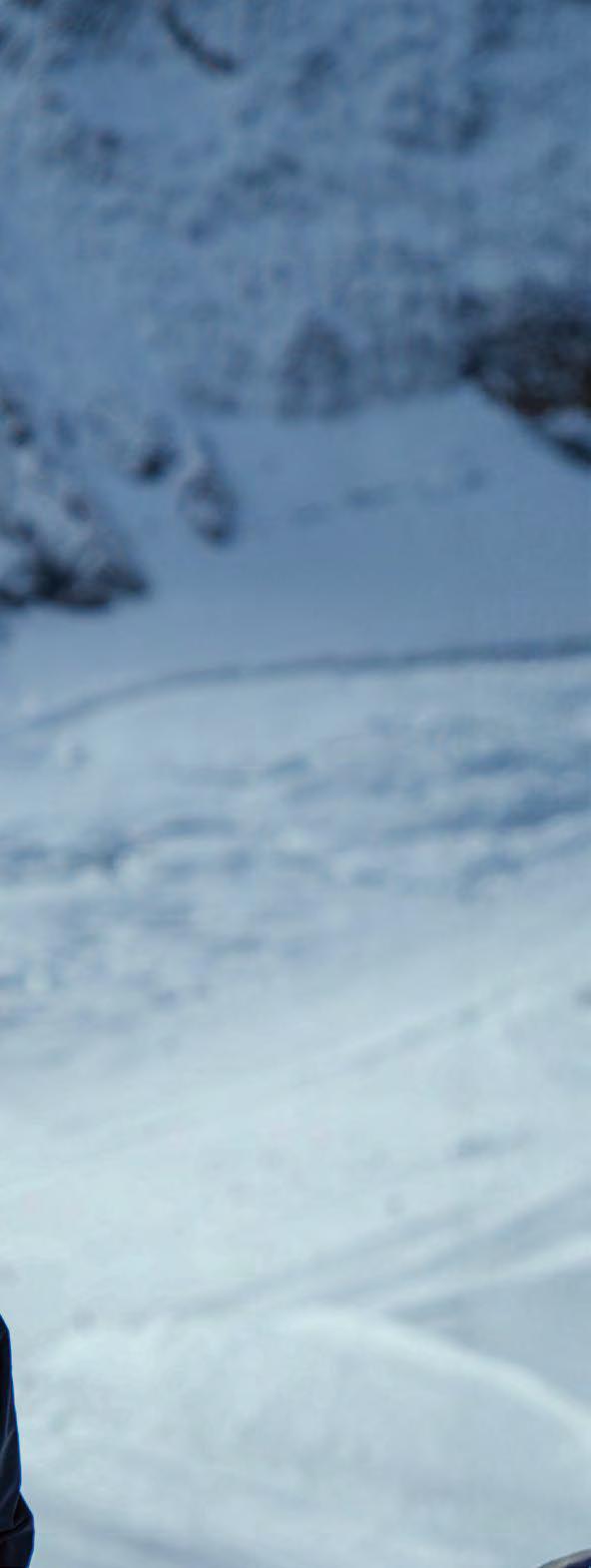
Most of us are capable of so much more than we think we are. When we chose to come to Burke we chose not to be most. We chose to be that one-in-a-million who push themselves to their limits and beyond. We came from all over the world to this postage stamp in Nowheresville, VT. This collection of eight or nine red houses on the side of a mountain. We came for the same, simple reason. To find out just how far we can go. Here, we choose to know. Here, we Chase Greatness.
 by WILLY BOOKER’96
by WILLY BOOKER’96
As fall in the Northeast Kingdom unfolds outside my window, it feels almost bittersweet to redirect our focus to the very season that gives us purpose. Today, with renewed enthusiasm, I write about the state of our school and the optimistic atmosphere that permeates this academic year. The campus culture and “vibe” feel particularly strong. Following an in-depth brand audit and our collective reflections on the unique Burke experience, BMA’s timeless mission stands reaffirmed.
Mission: To Champion Ski Racers Chasing Greatness.
Vision: To Be the Best Ski Academy in the World. Our 50-ish celebration emphasized the evident and enduring influence Burke has on its alumni. Not only do Burkies excel in their chosen fields but many credit BMA with shaping their foundational abilities and character. Given the changing landscape of ski racing, education, and work, are the skills and values fostered at Burke still relevant? I believe they’re as crucial now as they have ever been.
The world needs individuals who value hard work, critical thinking, intellectual risk-taking, and most of all, collaboration—qualities that Burke continually fosters. But are we doing enough? Success hinges on engaged and dedicated student-athletes. We’ve always believed that a blend of academics, athletics, and community cultivates holistic student growth. Today, coaches are free to coach; teachers can focus on teaching; and students can grow, learn, and be kids. By reaffirming our mission, vision, and dedication to the pursuit of greatness, we ensure the invaluable skills that benefited past students are actively nurtured today. We’re deeply thankful for your unwavering support. Here’s to a fantastic year. I’ll see you on the hill.
Willy Booker, Head of School

THE ONES WHO SAY YOU CAN’T ARE AFRAID THAT YOU WILL.

A weekend-long celebration of the community that shaped us all.
by MERYL WILLETTLast June, over 500 intrepid alumni celebrated BMA’s 50th Anniversary with a weekend of festivities, honoring the school’s legacy and the community that built it. The vibe was pure pride and nostalgia complete with all the feels.
Amid raindrops Friday night, Burkies gathered around a crackling bonfire, and later shared hugs and laughter in the Frazier living room while poring over old photos and stories. Saturday morning was a perfect Burke sight, with more than 30 people joining the 1.75-mile run led by none other than BMA HighPerformance Director Darrell Gray. After that, the event unfolded with food, drinks, live music, mountain biking, hikes, yoga, and, for some, a nostalgic stay in their old dorm rooms—for those who wanted to re-embrace life in the Northeast Kingdom as it was in their student days.
On Saturday evening, Parker Biele (BMA ’17) and Ben Roy (BMA ’02) took the stage to deliver their keynote speeches. They both reflected on the ways BMA shaped them into the people they are now. “Burke is a very special place that raises young athletes to succeed in whatever they set their minds to,” said Parker. “I walked onto this campus 14 years old, four foot nine and 89 pounds. I had no family ties to ski racing whatsoever, but I knew I was meant to be here.”
When Head of School Willy Booker (BMA ’96) took the stage, a collective roar erupted in honor of all

“The legacy of our alumni is the real story of Burke Mountain Academy. The integrity, work ethic, friendships … that’s what we’re really here to celebrate.”
— WILLY BOOKER’96

current and former BMA staff. A standing ovation then followed honoring the first Burkies—those students who took the biggest risk on Burke and, by doing so, made the academy’s foundational years possible. It was a poignant moment that underscored the enduring sense of gratitude and community that defines BMA to this day. Willy went on to address the pivotal role BMA played in shaping so many lives, highlighting a number of remarkable Burkie achievements from a wide range of athletic and professional endeavors. “The legacy of our alumni is the real story of Burke Mountain Academy. The integrity, work ethic, friendships—just watching everyone reconnect here now—that’s what we’re really here to celebrate,” he said.
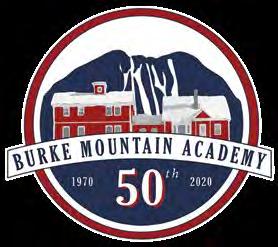
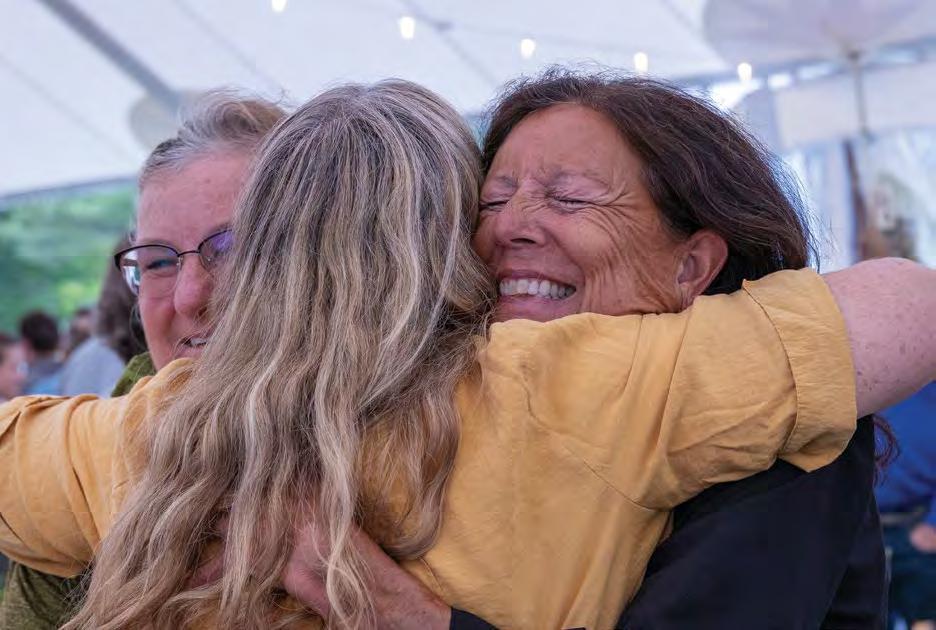
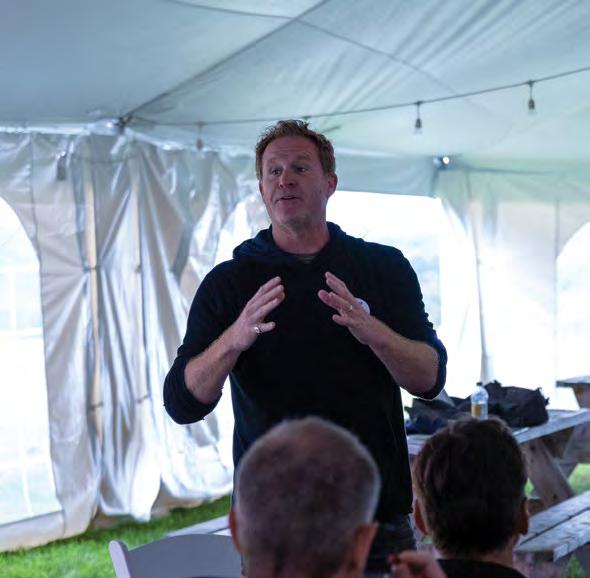


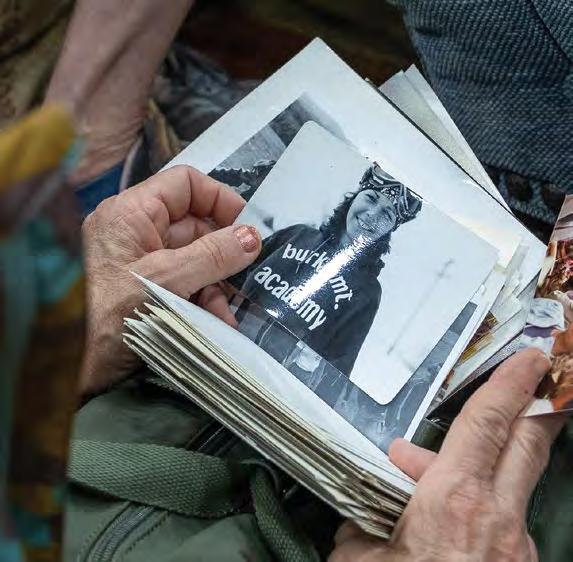


FRITZ BRUMDER’97
“Obviously, the glue of Burke friendships is the passion for sport, but it goes far beyond ski racing and soccer. During my time at Burke, we played tennis, hockey, and Frisbee golf. We even made it to the VT State Championship in track. We didn’t have track uniforms and I remember the other VT state teams looking at us like we were the Bad News Bears, not the Burkie Bears.”
A collection of stories and reflections from the 50-ish Anniversary that only Burkies could tell.
“Martha Coughlin was the first student I met at BMA. She was my first roommate and friend. I miss her. In that first season at Burke, Warren used to drive us down to Lyndon State College for three meals a day, weight training and, occasionally, an arts class. As more classmates arrived, we hired a cook whom I’d help in the kitchen. (I needed to keep busy because I’d broken my leg in December during our first BIG snowfall of the season.)
That spring, a few students transformed a threecar garage into three comfortable bedrooms at the Moulton farmhouse. There are hundreds and thousands of memories that happened at BMA. I hope everyone has good ones to cherish.”
“Ronnie loved to DJ the dances at BMA. We lived about five miles from campus. He lived on campus in the fall and spring but lived with us in the winter. One winter Saturday night, he was leaving for campus, and I asked him when he would be home. A parent always wants to know when to expect their child home after a party. Ronnie said, ‘At 10:07. Curfew is at 10, then I’ll be home.’ This struck me as so unusual to hear from a teen. I was thankful he had a place to go, where he could enjoy being a young person, and that place was safe due to the zero-tolerance policy on drinking and drugs and the strict schedules they (BMA) always kept. What an incredible safety net BMA is for students and their parents!”
“I have two favorite Burke stories: one is when Warren pulled a schoolwide prank on top-seeded tennis player Steve (Cracker) Graham by telling him the kid from Michigan coming to school in the fall (me) was a nationally ranked tennis phenom. (Of course, I’d never so much as held a tennis racket.) A very nervous Cracker, with the whole school lining the court and in on the joke, hit two
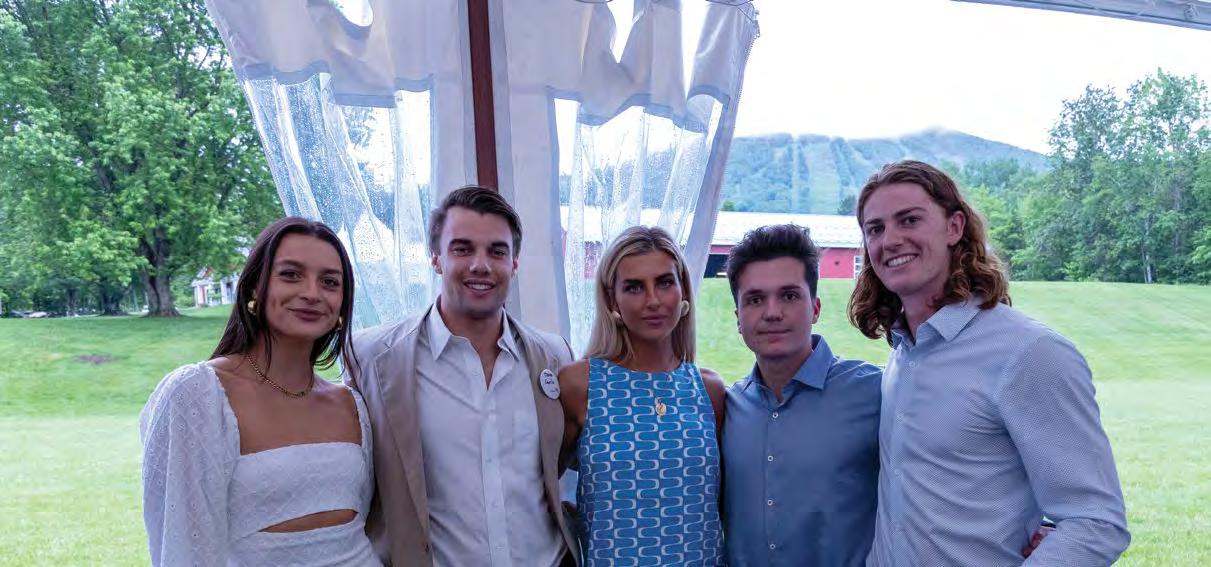
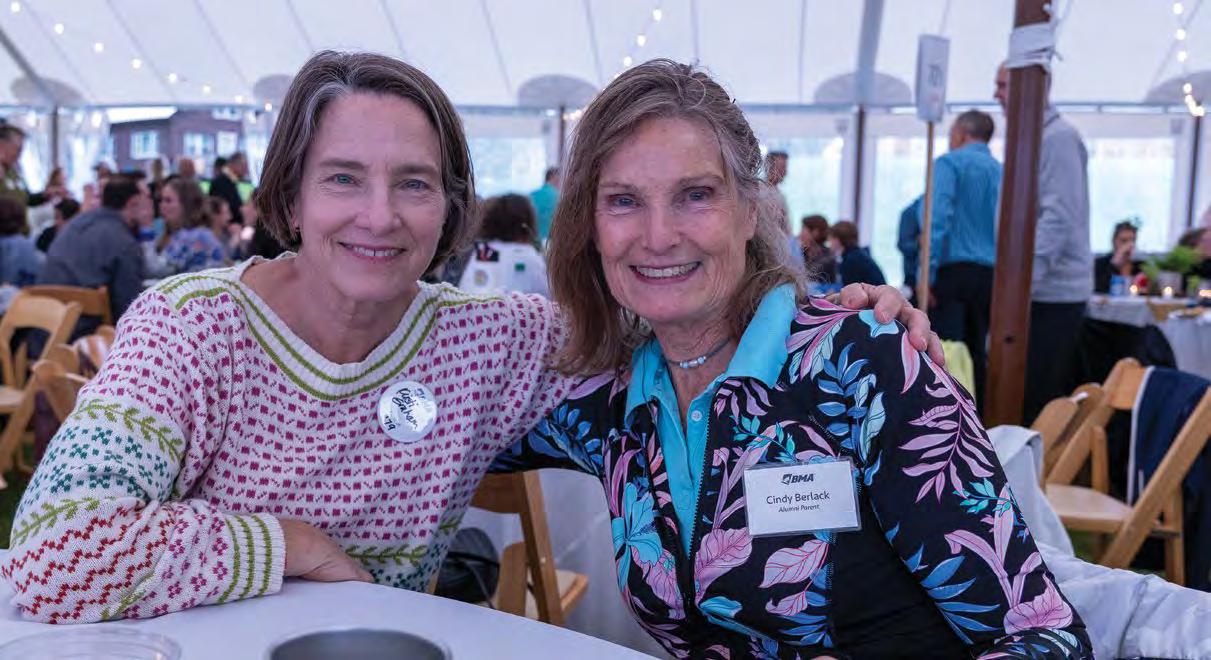
serves to me. I missed the first one and barely hit the second. At that point, the joke was up, and we all had a good laugh, Cracker included.
“My other favorite story is about how Burke—staff from Warren to coaches Rau, Jones, and Shoenfeld; locals like the Graham, Murphy, Mikel, and Hazelhurt families; and teachers like Richard Enemark—literally saved my life with their toughness, kindness, love, and nurturing. (I came to Burke from a pretty dysfunctional family/ community back in Michigan.) Post-Burke, I would eventually hit bottom with drug and alcohol addictions at around age 23. Eventually I sought help, which saved my life. And I am quite sure that I only did so because of the love, kindness, and attention I received during my years at Burke.
Somehow I’d manage to skirt serious trouble during the summers home in Michigan just long enough to fall back into the safety, structure, and love of Burke come fall. Had I not had the Burke experience, my life would’ve been dramatically altered if not prematurely ended. Of that, I am
quite sure. My gratitude and heartfelt thankfulness for Burke are beyond words.”
VIKI WOODWORTH’74, AP ’05“One of the strongest memories I have, and one of the earliest, is just sitting around the picnic tables. That was our dining room at the time in the Academy building (now called Frazier House). I was so blown away that the teachers and coaches sat with us—and not only sat with us, but actually talked to us—and that they cared about what we said in such a sincere and genuine way. Meals were a gigantic highlight of every day. The school was so small that everyone could hear everyone, and we all laughed so hard and learned so much at those picnic tables. I’m sure it helped my self-esteem and confidence to feel respected by grown-ups like that. I remember early on, when it was my turn to speak and I sort of had the floor, it was outrageously hard and awkward for me. I’d get all red in the face and so terribly nervous. But over time I got better and better, more and

more confident, and I enjoyed it more. It was such a cool transformation to experience and one of my favorite memories, maybe my all-time favorite memory, and to this day I still remember it vividly!”
“In 1976, at age 23, I embarked on a journey to teach and establish an art program at Burke Mountain Academy. This entailed shoveling sawdust in the newly constructed art room, located above the dining room at the end of Frazier House. For weeks, sawdust continued to seep through the floor onto dining tables.
“Shortly after my arrival, Steve Graham (BMA ’77) and Jeff Darrow (BMA ’76) approached me with an unconventional request: would I want to teach a dance class? Jeff had completed his mother’s ballet class and Steve was honing his breakdancing skills, which was enough to pave the way for twice-weekly modern dance sessions. By December, we had prevailed over the sawdust, leaving the art room to flourish as a space for creativity. Steve, Jeff, Laurie Baker (BMA ’76), and Dawn Janerich (BMA ’80) choreographed and performed a piece at the annual BMA Christmas party that year. The art tables doubled as our dance floor.
“The art room would go on to become many things. Often, it was an art gallery adorned with hanging works and sculptures. But every Halloween it metamorphosed into a haunted house, offering thrills to blindfolded daredevils. Then come winter, it became our hub for handcrafting race result boards for all our Burke-sponsored races.
“Friday and Saturday nights, we’d be there meticulously transcribing Judy’s race sheets onto posters for the next day’s race.
“And then spring always ushered in a two-week arts festival that featured jazz performances, Shakespearean scenes, and interactive sessions like printmaking and bookmaking. There was always something wonderful happening there.
“Reflecting on my time at Burke, my memories are as diverse as they are abundant—from our quirky lunch rituals and impromptu ice cream sundaes to wilderness weekends, trampolinecentered festivities, and unforgettable wholeschool experiences like the Green Mountain Run. Each memory is a brushstroke that contributes to the vibrant canvas that was my life at Burke Mountain Academy.”
“I’d never considered Burke an option for me (having grown up out West) nor, later on, for my kids. It just seemed too Spartan, too hardcore. But as life went on, I saw the bond that all Burkies seem to share. This kind of quiet brotherhood and sisterhood that bonds them. Now when I think of Burkies, especially the way they show you who they are, versus telling you, I am reminded of the Emerson quote, ‘Who you are speaks so loudly I can’t hear what you’re saying.’ When my own kids were looking at ski academies, there was only one that spoke softly but delivered loudly; it was Burke. I remember Darrell sitting next to my son and talking about how Burke tries to take the pressure off the kids, which frees them to perform better. This was in direct opposition to the approach everyone elsewhere had proposed to us and, I knew right then, my son was hooked. And so was I.”
A permanent tribute to the enduring spirit of our friend Rolf Gidlow.

For 22 years, Rolf Gidlow dedicated his life to Burke Mountain Academy and to coaching ski racers, but Rolf’s real influence extended well beyond the slopes. Rolf was a catalyst for all BMA students. He inspired all of us to chase our passions, whatever they may be. He generously shared his love of literature, music, golf, and nature—plus a kaleidoscopic array of other interests and pursuits—with anyone and everyone. Sadly, our dear friend Rolf passed away in 2022 after a courageous battle with cancer. His passing left us a legacy defined by his humility and his insatiable intellectual curiosity.
by MERYL WILLETTSurrounded by family and friends, amid the Northeast Kingdom’s vibrant foliage, Burkies gathered to honor Rolf in a ceremony naming BMA’s newest dormitory “Gidlow House.”
Colleagues who had the privilege of working with Rolf, like Tom DeCarlo, reflected on Rolf’s multifaceted talents during the ceremony. DeCarlo shared, “I had 20 years to be around Rolf. I had an immense admiration for who he was—for his talents and his contributions to Burke students. He was a top ski coach in the country, but he connected with the students as a teacher … as a wise individual who could always see one’s inner person. That’s what made Rolf so amazing.”
Darrell Gray emphasized Rolf’s depth of character. “Rolf was not just a ski coach; in fact, our conversations during our travels rarely focused on skiing. Instead, we discussed music, poetry, and the literature he was reading. Rolf’s depth, quality, and breadth of knowledge is what drew me to him. He may not have intended to be a mentor to me, but that’s exactly what he was.”
Head of School Willy Booker (BMA ’96) fondly reminisced about Rolf, calling him, “… a veritable BMA icon. Rolf was a role model in athletics and as an intellectual. That’s one of the most special things about Burke—a teacher can be your best
mountain biking partner, just as a coach can ignite your passion for reading. That’s why the naming of Gidlow House feels so significant.”




Gidlow house was made possible by the generous donations of several BMA families and opened its doors in the fall of 2020. Every school year, Gidlow House becomes a home away from home for 14 students. The building also includes two apartment spaces for staff. The development of Gidlow House aligns with BMA’s goal of enhancing the residential life experience for all faculty and staff and reinforces our commitment to the BMA community—an initiative that we hope Rolf would have been incredibly proud of.

Reflections on the remarkable woman who helped create Burke Mountain Academy.
by MERYL WILLETTIn any honest re-telling of the Burke Mountain Academy story, it would be hard, verging on impossible, to overstate Martha’s importance. Hailing from Swampscott, MA, Martha wasn’t just a young ski racer; she would go on to become the co-founder of the first and one of the most innovative, respected ski racing academies in the world. Her story is woven into the very fabric of Burke Mountain Academy.
But before she accomplished this extraordinary feat, she first had to accomplish another, no less extraordinary, one: she had to envision an entirely new kind of school—a place where academics and alpine ski training would seamlessly coexist. Once she did, she pursued her vision with relentless determination and ingenuity. She sought a person who could help her turn her dream into a reality. In Warren Witherell, BMA’s other co-founder, she found that person. Now let’s scroll back to 1969, where we’ll hear about Martha’s role in the founding of BMA through an excerpt from One School That Works, Warren Witherell’s book about the school’s early years:
It says on the diplomas you receive at graduation that Burke Mountain Academy was founded in 1970 by Martha Coughlin (BMA ’73) and Warren Witherell. You’re all familiar with the Warren guy, but who was Martha? Where did she come from? And what role did she play in starting the school?
Martha Coughlin was a fourteen-year-old high school freshman from Swampscott, Massachusetts. Who could have imagined in the fall of 1969, before she came to Burke, that this young girl would begin a school? I wonder if there are any other schools in America that a ninth-grade student founded? I’ll wager not!

I often tell people that, “Most schools are founded by adults who are unhappy with existing options for their children. But Burke was founded by a child who was unhappy with existing options for herself.”
Martha Coughlin did two things right to start a school. First, she dreamed about combining school and skiing; second, she asked the right person to help her.
coaches were paid from Monday through Friday. My idea of a training center was a place where race training with a full-time coach was available seven days a week—all day. And any racer from anywhere could come and train on school
“I talked with Stowe, Killington, Waterville … they all said, ‘No way. We can’t afford it …’”
I began thinking as early as 1963 about starting a school that would offer serious ski racers half a day on snow and a flexible education. I was then 28 years old and had been teaching for seven years. I had non-traditional ideas about education and dreamed of becoming a headmaster someday.
There was no ski club or racing activity of any kind at Burke in 1969. I would have to start from scratch at Burke. That meant some big challenges, but it also meant I could do things my way.
Well, I talked to Mr. Kitchell about an Alpine Training Center. At this point (we’re in the spring of 1969), I had no thought at all of an academy or even a tutoring program. The East and the nation needed an Alpine Training Center. I was anxious to start one, and Mr. Kitchell had a mountain on which a dozen skiers were a mid-week crowd. We could set gates anywhere.
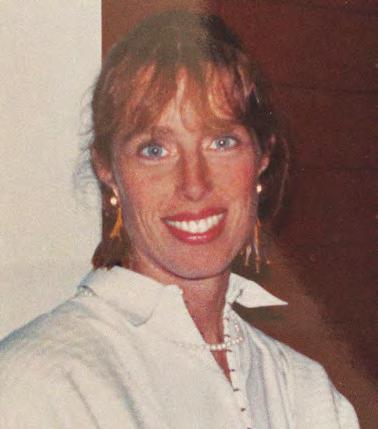
I have to give you some background now; that will be hard for you to believe. In 1969, there were no full-time (i.e., mid-week) racing programs in the entire USA. Besides some prep school teachers coaches, no racing
holidays, personal holidays, family vacations, or whatever. I talked with Stowe and Killington, and Waterville about this kind of idea, and they all said, “No way. It would cost $100,000. We can’t afford it.”
Could it then be done at Burke, where they counted ticket sales in tens instead of thousands?
Mr. Kitchell said he would enjoy having young people on the mountain. He would welcome the racing activity, but he was already losing money and couldn’t afford to lose anymore. In the end, he said: “If you can start a training center here that won’t cost me any money, be my guest.”
I returned to New Zealand in the summer of ’69… just before starting at Burke. This time I took just six racers—one of whom was Martha Coughlin, age 13, from Swampscott, Massachusetts. Martha had been racing weekends out of North Conway. She was one of the best in the East with a gift for speed, a soft touch on the snow, and big dreams. She came to Burke for all her Christmas vacations and planned to train with me here whenever she could throughout the winter.
On New Year’s Day, at 4:30 in the afternoon, Martha finished packing her things in her dad’s car to return to MA when she stuck her head into a circle of ten or twelve people talking with me in the parking lot. “Hey gang,” she said, “it’s been great; thanks for everything.” Then, after a pause,
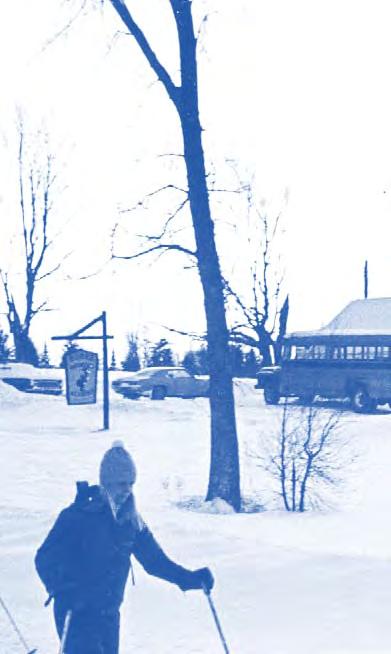
she added what seemed a spur-of-the-moment afterthought, “Warren, this may sound silly, but if I could get out of school for the rest of the winter and find a place to live up here, would you tutor me—you know, so I can keep up my schoolwork, and ski with you guys every day?” The assembled group all laughed at Martha’s little girl’s imagination. No one thought she was serious. I chuckled to myself, but never being one to squelch a kid’s enthusiasm, I replied: “Sure, Martha, no problem. Good luck.” And Martha disappeared.
On Monday morning, Martha, a 110-pound freshman with a great big smile, had walked into the principal’s office at Swampscott High School, looked the boss-man straight in the eye, and told him she wanted to be an Olympic ski racer. She said she had the talent but needed training; she had a coach and a school tutor in Vermont and wondered if she couldn’t be excused from school for January, February,
“
Two days later, Martha returned with her skis, schoolbooks, barbells, and a big smile. ‘I’m here ‘til April first,’ she announced.
‘Where can I live?’”
and March. She said she would take full responsibility for studying, keep up her work, and return to Swampscott even with her classmates in April. Wow! Today we call this the Burke Spirit.
The school principal pushed his chair back, looked into this young girl’s eager eyes, and judged he was talking to a winner. “Martha,” he said, “there’s more to life and many more ways to learn than are encompassed by the brick walls of this old building. Yes, you can go. I’ll smooth the road with your teachers. But this arrangement involves a promise: you will be even with your class when you return. No compromises. I’m going out on a limb for you where school principals aren’t supposed to go. Don’t let me down.”
“I won’t,” said Martha. “Don’t worry!” And she floated out the door to alight the next day on the Training Center steps. We found a place for Martha to stay on the mountain—with Joe Pete
By year’s end, Martha had earned a berth on the US Ski Team …. As you might expect, some (other skiers) soon asked if they could do what Martha was doing.”

Wilson, his wife, and two kids. Joe Pete was the Mountain Manager then, and the Wilsons lived (can you believe?) right in the Frazier House. So this was Martha’s home. She traded babysitting services for a free room and paid enough for her meals.
At this time, I was the only coach at the Alpine Training Center. I was on the snow daily from 8–4 and usually worked from 7–6. I had a little time for tutoring Martha. But she had all her assignments and all her books. I had an office in the Training Center. While I was on the mountain every morning, Martha was at my desk, studying from 8–12. Even on powder days, she did her four hours of study first. She skied in the afternoons.
How much did I tutor Martha? We spent, at most, two or three hours all winter. That’s it, plus some time to talk about her work while riding on the chair. Essentially, Martha taught herself. I asked her every few days if she was caught up and if she really understood all of her work. “Oh, yes,” she said. “I’m way ahead of my class so I can go to Colorado for the spring races and not fall behind.”
And ahead she went. And off to Colorado, and she went back to school in April. And her spring term grades were the highest she ever had in school. She kept her promise to the principal. And she taught me something or reaffirmed what I already knew: schools are terribly inefficient, and kids can learn quite quickly whatever they want. That was an important foundation on which the early Burke Mountain Academy was built.
Oh - I almost forgot. Somewhere back that winter, Burke Mountain Academy was born; it was a sunny day in the middle of February. I came down to the Training Center after the morning coaching session, ready to join Martha for lunch, and found on the Training Center door a brightly lettered sign done with red and blue marking pens. The sign read:
BURKE MT. ACADEMY FOR SELF-MOTIVATED STUDENTS AND HUNGRY SKI RACERS
In a moment of mirth and creative thought, Martha had made the sign and posted it on the door. It was the first time the words Burke Mountain Academy had been formed together. No one had ever spoken of starting a school in conjunction with the Training Center. I hadn’t even thought of Martha as the first of perhaps many tutorial students. She was just a rare bird lucky enough to be doing her own thing.
What Martha was doing, of course, was skiing every day and doing an end run around many girls ahead of her on the seeding list. By year’s end, she had earned a berth on the US Ski Team. You can bet that other racers and their parents were well aware of her advantages.
As you might expect, some of them soon asked if they could do what Martha was doing. Would I organize a formal tutorial program for the following winter and accept additional students?
The rest, as they say, is history. Martha’s fearlessness and tenacity have been inspiring generations of “hungry ski racers” ever since. To this day, her passion fuels and enables our own passion for the sport, our own collective pursuit of greatness. So in October of 2022, Martha’s fellow Burkies, members of Martha’s family, and friends from around the BMA community gathered to unveil a plaque in memory of this remarkable woman, this person who changed all of our lives.
Thank you, Martha.
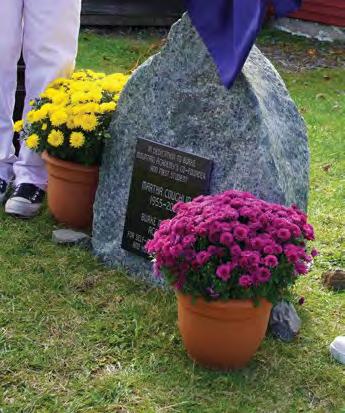
A remembrance and celebration of Richard Enemark.

Richard Enemark was a BMA English teacher, college advisor, and academic director from the mid-1970s to the early 1980s and was a member of the BMA Board of Directors in the late 1990s to early 2000s. He died recently at the age of 73. Richard is survived by his daughter Faith, his son Forrest, his grandson, Hunter, and his sister Dawn.
by KRISTIN HODGKINS MACOMBER’76It’s been nearly five decades since I first met Richard Enemark, but I remember it like it was yesterday.
I had just arrived at BMA when I wandered into the Frazier House and heard someone holding court in the TV room. The speaker, whom I could hear but not quite see, was describing a movie he’d recently seen and the embarrassing effect it had on him.
I poked my head through the doorway just in time to witness my soon-to-be English teacher reenacting precisely how he had landed in the lap of a total stranger at a terrifying moment in that summer’s blockbuster, Jaws, to gales of laughter.
Storytelling was Richard Enemark’s stock in trade. He loved sharing his favorite authors, from Austen to Tolstoy to Dickens, and he took pride in making Shakespeare as accessible to a group of teenaged ski racers as it was to the groundlings at The Globe Theater in the 1600s.
Richard was also a teacher who insisted that when we write, we get the grammar and punctuation right. Commas were turn signals to Richard, to let the world know where the writing was headed. Verbs needed to be active not passive. Fewer, more carefully chosen words were always better than too much verbiage.
Richard took pride in turning his students into capable self-editors, and he reveled in our collective progress toward clearer writing. It was Richard’s steadfast belief and encouragement that compelled more than a few of his students to become future published authors.
But no matter what course the lives of his students took after graduation, every kid who ever sat in one of Richard’s classes was the recipient of a sense of bravery around tackling hard reading assignments. Once you’ve powered your way through War and Peace, no story is too intimidating.
Richard moved on from BMA to Columbia University, where he earned his Ph.D. with highest distinction. From there he continued to teach his beloved authors and preach the written elements of style while taking on leadership roles, including head of school for multiple institutions. After his intended retirement, he accepted one last temporary teaching appointment, which was happily extended for eight years. Those years were Richard’s Mr. Chips curtain call, his one last chance to share his belief that stories well told are our best textbooks for compassionately understanding the human condition.

visits … Care about the not so lucky,
In a speech he gave to the graduating seniors at the Stevenson School in California, just a few months before his death, Richard offered these words to his last generation of lucky students:
“For those of you who’ve read Dickens with me, or even if you’ve only watched the Mickey Mouse cartoon of A Christmas Carol, think of it this way: be Scrooge, but be the Scrooge he became after the ghosts’ visits. Let yourself care about the not so lucky, not so wise, not so well off Cratchit family. Care for them as if they were your own, as if Tiny Tim was your brother. Acknowledge the pain of another, the vulnerability that you wish someone would fully recognize in you. As Dickens put it, recognize and admit that we are all fellow passengers on our way to the same end—the grave. Admit it when you’re wrong, welcome a stranger, protect an outsider, embrace even an enemy.”
“For those of you who’ve read Dickens with me … think of it this way: be Scrooge, but be the Scrooge he became after the ghosts’ visits … Care about the not so lucky, not so wise, not so well off Cratchit family.”
— RICHARD ENEMARK
Rest in peace, Richard Enemark—a good writer, a good friend, and the best teacher I ever had.


BMA coach and Olympic and world champion Diann Roffe’85 talks junior development.
by EDIE THYS MORGANDiann Roffe retired from ski racing in 1994, capping off her career with a gold medal in the Lillehammer Olympics and a victory in her final World Cup race. She left the elite level of ski racing at the top of her game, but she never left the sport.

Now, Roffe is starting her fifth year at the helm of Burke Mountain Academy’s junior program, an endeavor she took on and designed with former USST teammate Felix McGrath. Together, they hoped to create a program that was both high level and accessible.
It took them two years to assemble the current model, which has flipped participation from more than 80 percent out-of-state weekend skiers to more than 80 percent full-time local Vermont skiers in just two years. Roffe has well-informed thoughts on what it takes to develop young ski racers.
Roffe grew up skiing at tiny Brantling, NY, then attended BMA, where she became World GS champion at age 17 while still a high school student. She went on to win Olympic GS silver in 1992 and Super-G gold in 1994. After retiring, she earned her PSIA Level 300, led various women’s clinics, and started coaching. As head women’s FIS coach for NYSEF, she also guest coached for the US Women’s D Team as young athletes Resi Stiegler, Lindsey Kildow (Vonn), and Julia Mancuso were coming up the ranks. In 2002, she started coaching at Ski Roundtop, PA, eventually becoming program
director for 100 athletes and 22 coaches. In June 2019, she signed on to Burke to run their junior program while McGrath was coming to Burke as sport director at the academy level, having been general manager of Baerums Ski Club and Donski Ski Academy in Norway.
Together, they tried to replicate some of the magic of the Norwegian model that prioritizes the love of the sport and combine it with the American love of competition. They envisioned a full-time program that utilized BMA’s infrastructure and allowed kids to live at home and attend their regular schools.
When Roffe started, Burke’s junior program largely comprised Massachusetts weekend families. Their mid-week Devo program worked with only a handful of kids, whose training time eclipsed what was available to the weekend kids. Roffe’s goal was to flip that script to say, “The full program is our program, and then another option is the weekend program.”
While BMA worked on structuring a seventh- and eighth-grade academic program that utilized their classrooms and training venue at opposite
“Our job is to take every athlete who wants to ski race, regardless of their level, and coach them to improve. Every athlete should be able to improve from point A to point B every season.
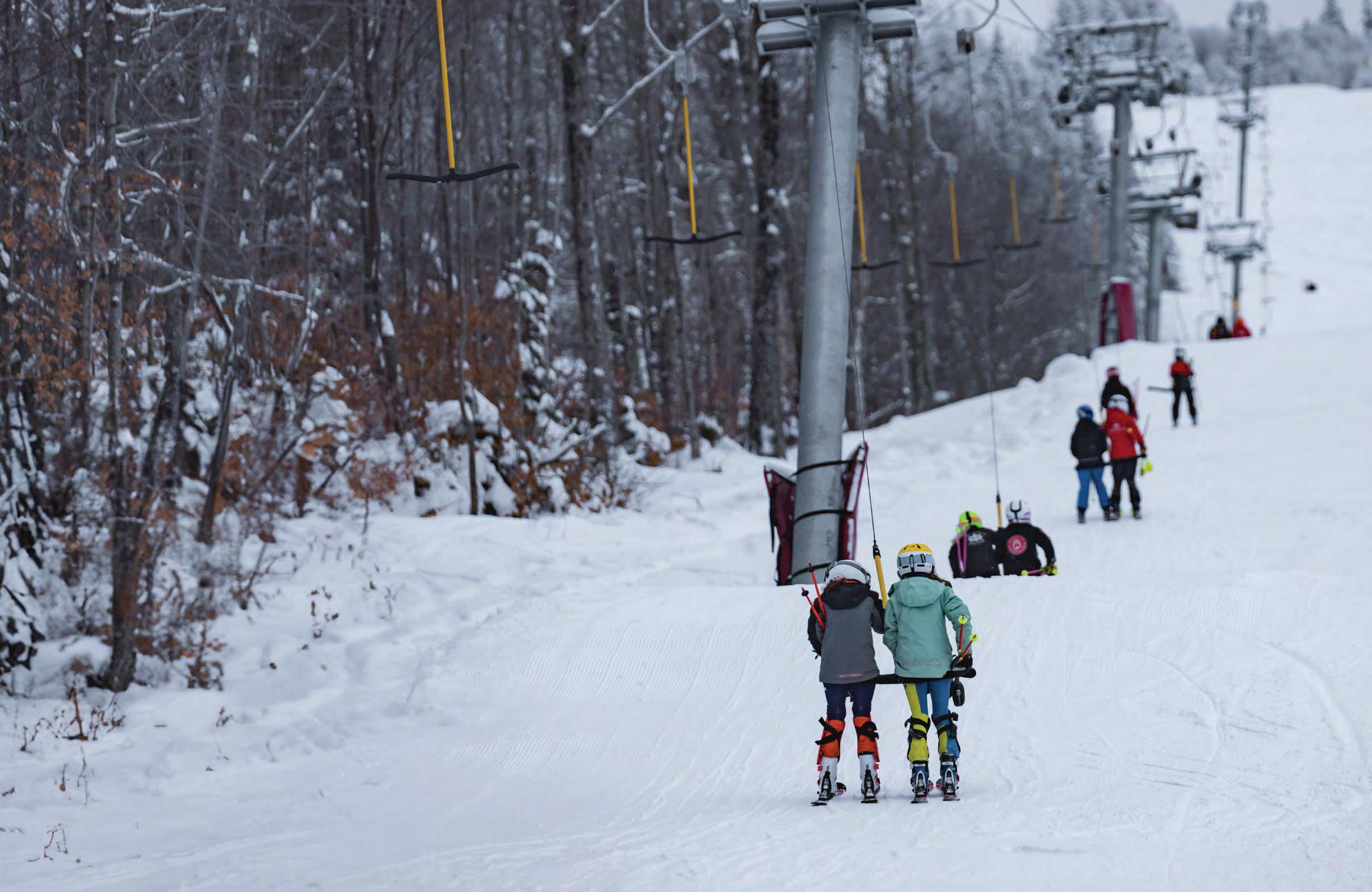
— DIANN
ROFFE

times from the academy, Roffe set about meeting with the four local schools to get their support. Vermont’s “Flexible Pathways Initiative” encourages public schools to create personalized learning environments beyond the classroom. In addition to a collaborative spirit, the state provides a blended learning coordinator who lives locally and manages all the teachers’ work with the kids and tracks each student’s progress. If kids need to stay in class and catch up on schoolwork, the schools contact Roffe, who lets the family know.
When asked if that takes up much of her time, Roffe is emphatic: “Not at all! I share our spreadsheet of our U12 and U14 calendars with the schools so they can see on a daily basis what the training is and when the kids are out of school. The parents don’t even really have to communicate because the schools all have access to the calendar.”
“The social environment matters more than your technical, strategic program planning.”
This article originally ran in Ski Racing Magazine June 16, 2023.


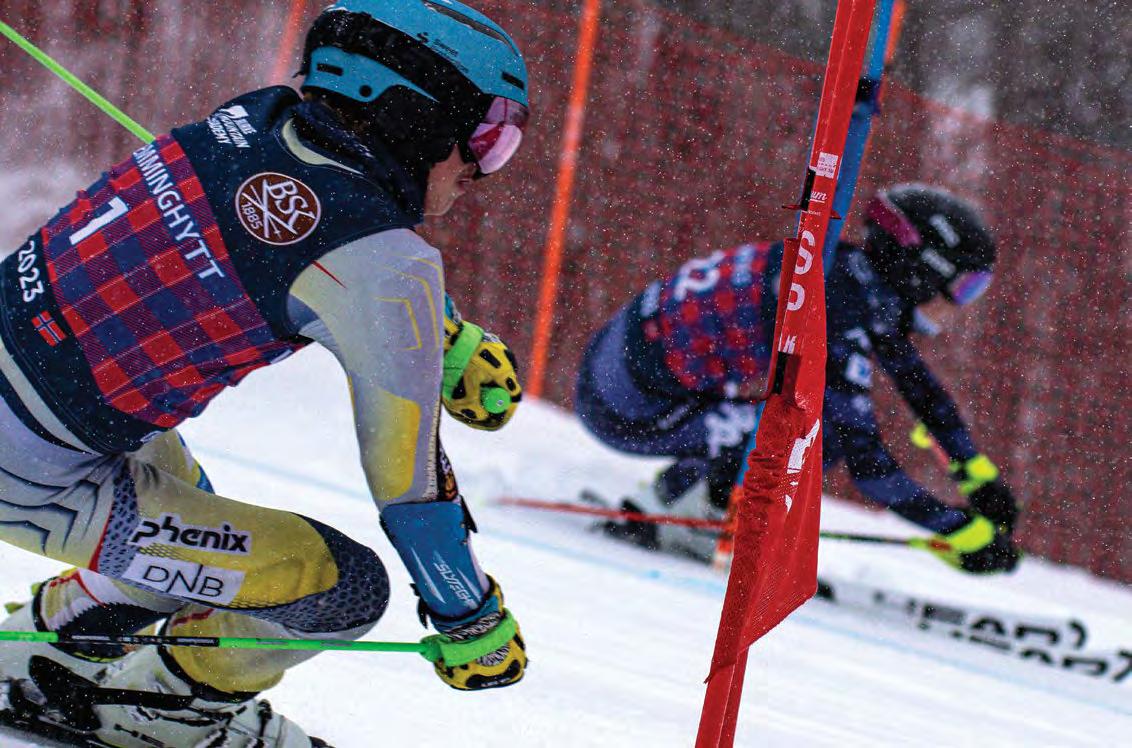
This incredible story began back in 2020, when BMA and BSK first outlined a partnership aimed at elevating training opportunities for both programs’ athletes while providing professional development opportunities for both programs’ coaches. The plan was simple enough: BMA athletes would travel to train and compete with their Norwegian counterparts, immersing themselves in European skiing culture; then BSK would visit Burke to train at our renowned venue and experience life at BMA. However, as with so many well-laid plans, the pandemic threw a wrench into our shared aspirations.
by MERYL WILLETT
Fast forward to February 2023 when eased travel restrictions finally allowed 12 visiting Norwegian athletes, led by Program Director Martin Budal, and accompanied by members of Baerums Ski Club’s Board of Directors, to finally make the journey to BMA. Once here, the Norwegians fully immersed themselves in training alongside the Burkies.
For an entire week, BSK embraced the BMA life, residing in dorms, dining at the cafeteria, and participating in rigorous workouts and teambuilding activities at the Ronnie Berlack Center, a designated US Ski Team High-Performance Center situated in the heart of BMA’s campus.
Felix McGrath, BMA European Programs Director, expressed his enthusiasm for this next step in the collaboration, emphasizing the positive impact on young athletes. “We’ve been fortunate to provide our U16, FIS, and even post-graduate athletes with opportunities to train and compete with BSK in Europe. Now, we’re thrilled to welcome them to train with the Burkies on our home hill.”
While the BSK skiers undoubtedly benefited from the challenging training environment at Burke, the real benefit of this exchange lay in the cultural enrichment it offers. BMA’s U16 Head Coach,
Thomas Erhard, commented, “This is about connections between athletes. It’s an amazing experience that offers tremendous learning; years from now, they’ll remember this, they’ll remember each other. This is something they’ll never forget.”
Burke Mountain Academy Head of School Willy Booker ’96 summed it up this way: “Living and training together, making new friends, seeing a different perspective on ski racing, and the novelty of the situation itself, it’s inspiring.”
“This is about connections between athletes … This is something they’ll never forget.”

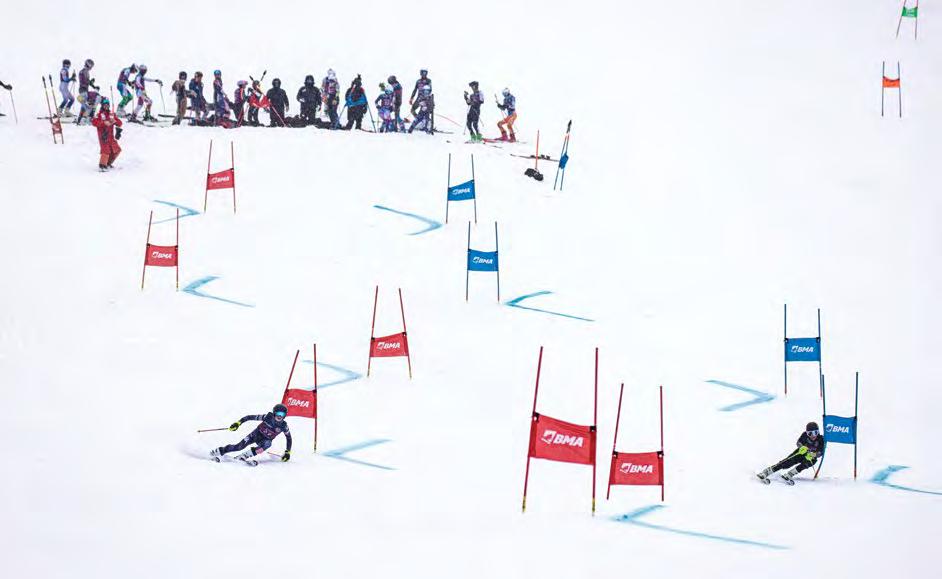
The week concluded with the inaugural BMA-BSK Mixed Team Parallel Extravaganza, an eight-team dual race that became an instant highlight of the visit.
As the ski tracks on Burke Mountain glistened in the winter sun, it was evident that this partnership was more than just a training alliance. It was a bridge between cultures and an avenue for lifelong learning. In the ever-evolving world of alpine racing, BMA and BSK are setting a new standard by creating a new model. Both teams eagerly anticipate 2024, when BMA will welcome BSK back to the Burke campus.

More than 20 BMA students and staff took a spring plunge into the icy waters of Lake Willoughby.
by MERYL WILLET WILLETT photos KENYON FATT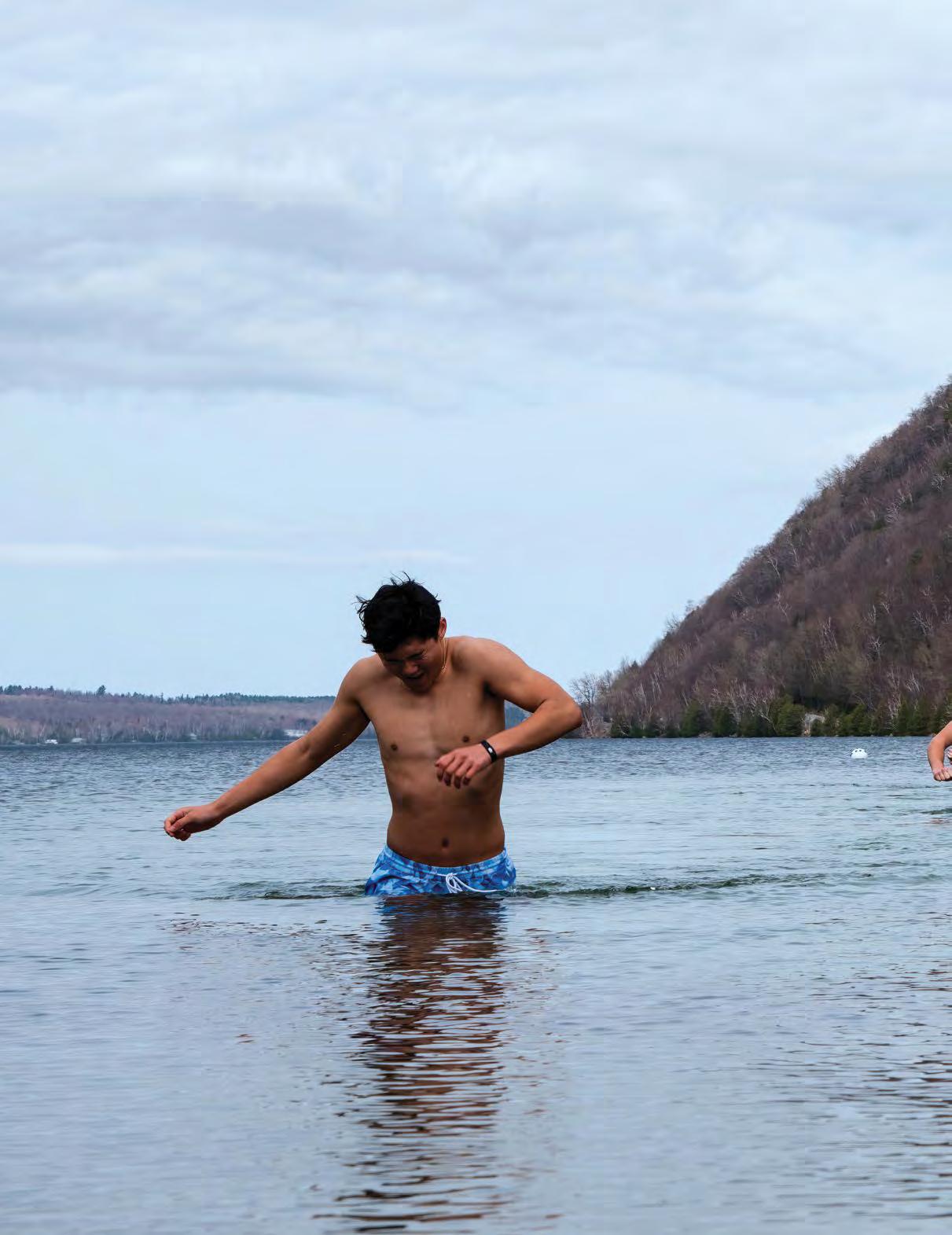


“I thought it’d be colder …”



Spring is slow to stir up here in the Northeast Kingdom, but we’ve never been a group to let a little weather get in the way of a good time. Kenyon Fatt, BMA STEAM teacher, saw the lingering chill as yet another chance for Burkies to come together, have some fun, and savor the last few weeks of school. On a whim, he invited any-and-all brave souls to join him for a trip to Lake Willoughby where the group would indulge in a Polar Plunge.
A late-April swim in 40-degree lake water might not be everyone’s cup of tea, but more than 20 students and staff piled into three vans and buzzed up Route 5A toward the south shore of Lake Willoughby. Together, they fearlessly plunged into the 41-degree Fahrenheit (5-degree Celsius) water and proceeded to, believe it or not, swim. Of the experience, one intrepid swimmer simply said, “I thought it’d be colder ....”
BMA students and staff were honored to be invited to the Vermont State House by State Representative Jed Lipsky (Stowe) for the official reading of HCR 87 on April 14, 2023.
BMA joins the Vermont State House in celebrating Mikaela Shiffrin’13 .
 by MERYL WILLETT
by MERYL WILLETT
The Vermont State House acknowledged Mikaela Shiffrin (BMA ’13) with a unique resolution that recognized her historic 2022–2023 season and record-setting accomplishments in World Cup alpine ski racing.
Rep. Lipsky took the opportunity to highlight BMA’s contributions to the sport of ski racing, BMA’s many notable alums, and specifically BMA’s Founder Warren Witherell, whom he credited with creating the first ski academy of its kind and for putting Vermont on the map as a place where competitive athletes can thrive, test their limits, and achieve greatness.
“Early on, BMA realized that for athletes to reach great heights, they needed a place dedicated to supporting their passion,” said Rep. Lipsky. “To achieve greatness, you need encouraging mentors, great coaches, and strong academics. BMA lead the way by creating a school that gives alpine ski racers the support they need to achieve their dreams.”
The passage of the HCR 87 resolution recognizes Mikaela Shiffrin’s exceptional accomplishments and acknowledges BMA’s role in nurturing young talent by providing top-tier training opportunities for athletes to reach their potential and compete at a world-class level.
“To achieve greatness, you need encouraging mentors, great coaches, and strong academics.”
Following the official reading of HCR 87, BMA students and staff were treated to a tour of the historic building led by Rep. Lipsky, which provided students with valuable insights into our state’s history and the opportunity to meet members of the legislature. BMA is thrilled to have participated in this celebration of one of our most distinguished alumnae. We are grateful to Rep. Lipsky for inviting us to represent our school and for showcasing the important role BMA has played, and continues to play, in the sport of alpine ski racing.
“A triumph.” “Remarkable.”
In January, Mikaela Shiffrin ’13 took home her 83rd World Cup victory in Kronplatz, becoming the winningest woman in alpine ski racing history.
At Burke, excelling as a ski racer is just one part of the narrative, but the more significant—and, in our view, better—aspect is the “why.” Why do our athletes continue to chase greatness in every facet of their lives? Many of these sentiments find expression in students’ term ends, a tradition at BMA that prompts reflection on their terms and encourages them to
articulate what holds the greatest significance. For Mikaela, in the spring of 2010, it meant contemplating the Whistler Cup as a J3.
“There is no time to be scared. I remember my coaches telling me, ‘One more run, Mikaela, put it down the hill.’ And that is exactly what I planned to do because I didn’t have anything to lose. This all started because it was fun, and it still is! I will “Put it down the hill” because that’s what I love to do. Period.”

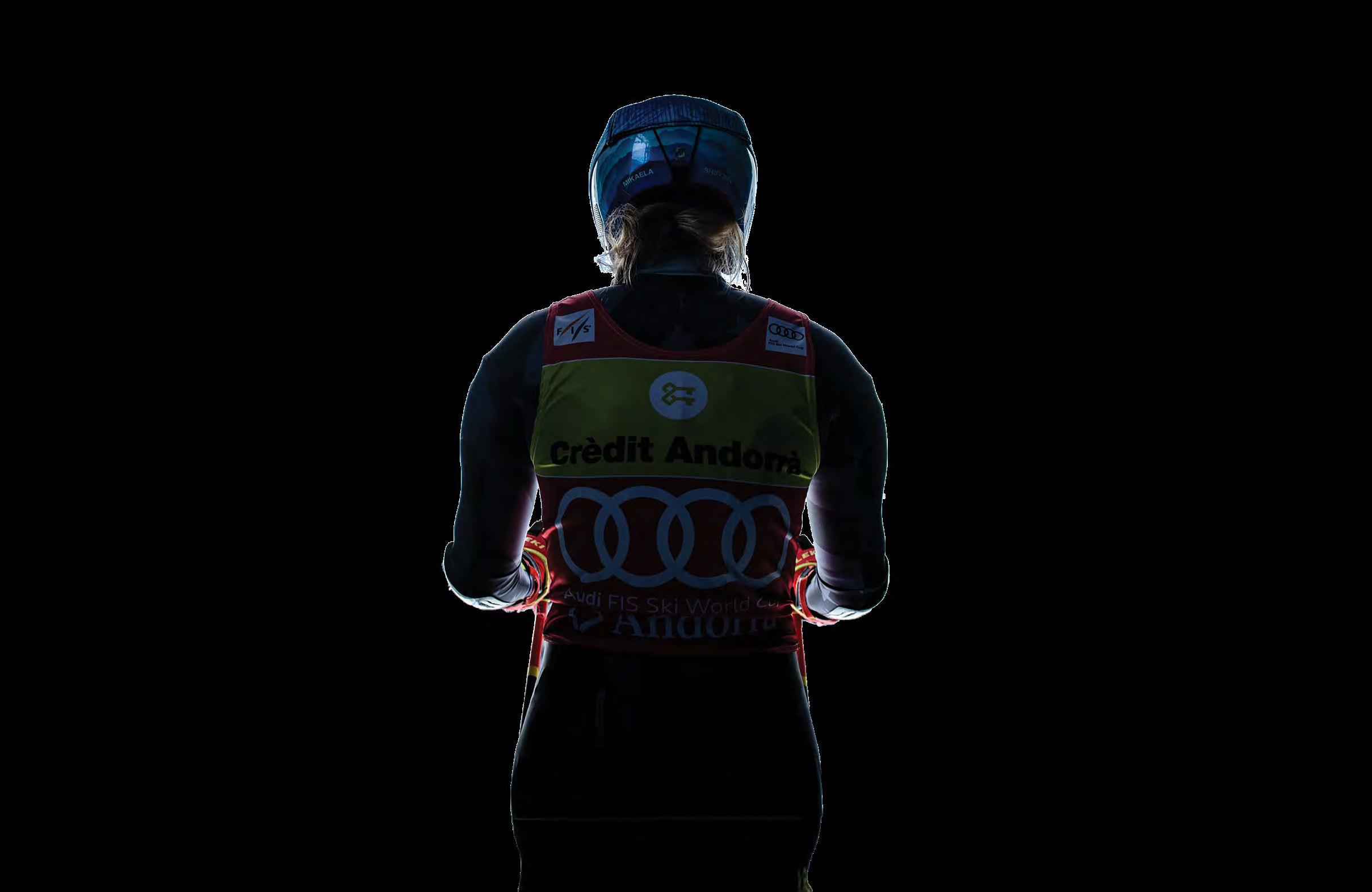

Olympian, Dad, and Burke Alum (’90), Erik Schlopy sits down with Willy Booker (’96) to talk skiing, life, grit, family, and success.
by WILLY BOOKERErik Schlopy’90 is a World Champion medalist, three-time Olympian (1994, 2002, 2006), and seven-time national champion who had one of the longest and most successful careers in US ski racing history. He is a World Pro Super G champion, World Championships bronze medalist, and the winner of an FIS Crystal Globe for his success on the World Cup. He competed in the World Championships six times from 1993 to 2007 and had 17 top-10 World Cup finishes. In 2014, he was inducted into the US Ski & Snowboard Association’s Hall of Fame. Erik lives in Park City with his wife and family, where he runs one of Utah’s most respected and successful real estate brokerages.
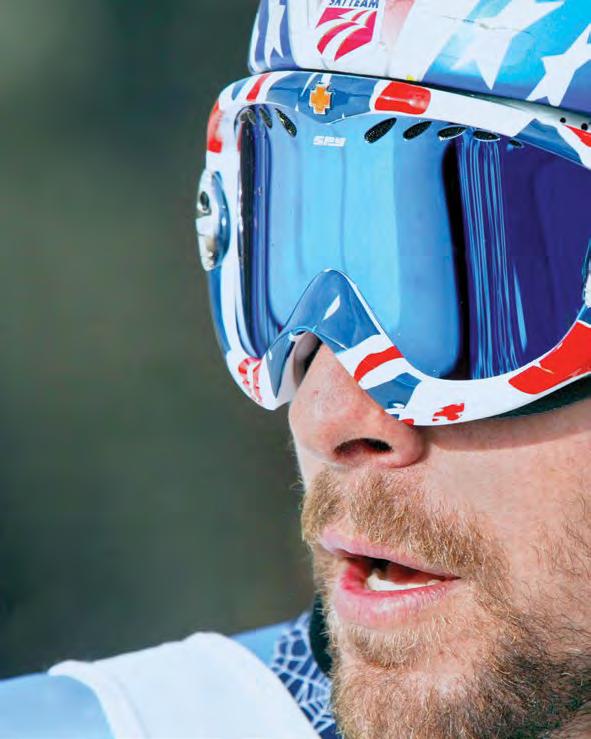
Willy Booker (WB): I had the opportunity to observe your career while I was a student at BMA, which was amazing and inspiring. Can you take us back to your time at Burke and how the lessons you learned played a role in shaping your journey?
Erik Schlopy (ES): I’ll always cherish my time at BMA and the lifelong friendships I made. I would say I have daily conversations with someone from Burke. When I dropped off my son, Spider ’26, we stood in this circle with the other families. I remember saying, “Get ready; it’s a lifelong journey, but you get to share it with friends.” For me, those friends became like family; we all came here to ski race, but we pushed each other and were committed to giving our absolute best every day;
we were all in. While it may sound like a tagline, it’s the truth. Every day, I gave it my all just to keep up.
WB: You’ve had an amazing athletic career. What are some of your most cherished memories?
ES: Fortunately, that career lasted a long time. I guess we could say it started at Burke, but it started even before that and lasted until I was 37, which is incredible. My most cherished memories, well, I’d say my second run in St. Moritz, that one stands out. After my first run, I was 23rd, and I moved from 23rd to third (Schlopy’s legendary comeback in 2003 saw him move from 23rd place on his second run to third, ultimately achieving the fastest time among the 83 finishers.

He finished just 1/100th of a second behind the silver medalist, Knauss, and a mere 4/100ths from the gold, as reported by The Chicago Tribune); that was an amazing day. The other one was my first top five. I don’t know if they still call it a podium, but it was my first podium. I started 33rd and ended in fourth in front of my hometown Park City crowd. That was a big breakthrough. That one sticks out.
WB: When you reflect on that run in St. Moritz, what did you take away from that experience that has informed other aspects of your life?
ES: After the first run, I was bummed out. I went back to the ski room and talked to my technician. I let go of my disappointment and returned with no expectations for the second run. I learned an important lesson, one that a US Ski Team psychologist had shared: “No expectations, no limitations.” I had put the work in throughout my life and, at some point, I needed to trust myself and let go of those high expectations that only tightened me up. It would do the same to anyone. So you put in the effort, let it roll, and trust that the results will naturally follow.
WB: I love that philosophy, “No expectations, no limitations.”
ES: It’s all about loosening up. Don’t turn the screws on yourself; that doesn’t lead to good outcomes. Individual sports like skiing can be incredibly demanding. Athletes tend to be extremely hard on themselves. When it comes to my son, for instance, I often ask him if he would treat his best friend the same way he’s treating himself after a tough day of ski racing. It’s essential to treat yourself with that same kindness and support.
WB: As you know, BMA is a unique place with a strong sense of community at its core. What are some of your favorite Burke stories?
ES: I have so many from my years there, but one of my favorites is from when I was a senior. It involves the five guys who attended Burke for all four years: Casey Snyder, Vance Schug, Dominic Robilliard, Casey Puckett, and me. We got together and choreographed an AirBand performance to the Jackson 5’s “ABC,” with Casey Snyder as Michael Jackson.
WB: Yes!
ES: It was unforgettable, so awesome. Anyway, we performed “ABC,” which was a total hit, and while we did it initially just for AirBands, it became the only performance requested to be done at graduation. We crushed it. That’s a good memory!
WB: That’s awesome, what a great story! Okay, so on the other end of the spectrum, athletes often encounter injuries and setbacks. How did you tackle those challenges, and what did you learn from those experiences?
ES: I’ve certainly had my fair share of injuries: four knee surgeries (both ACLs), a broken back in Japan (a significant compression fracture spanning six levels), a displaced sternum, broken ribs, a punctured lung, I even almost bit my tongue off once. There were pins and plates in my hands and so much more. I made it through all of them. For me, that tenacity came from knowing what I wanted to achieve. I saw it as my job to come out of those injuries healthier than when I went in. It wasn’t easy, but I had the opportunity to be an Olympic ski racer, and I knew that opportunity wouldn’t last forever. At some point, my skiing career would end, and I’d have the rest of my life to do whatever I wanted. It was always about playing the long game—figuring out what I wanted to do
and then determining how to make it happen. Ultimately, it was about digging in and getting it done.
WB: Is it fair to assume you’ve been able to apply those lessons to your professional career?
ES: There’s no way a professional athlete doesn’t learn skills that transfer to their professional career. Recovering from injury definitely makes you tougher. Recovery is part of anything: business, sports, relationships. You’ll always have to make a recovery at some point and knowing that you can only makes you stronger.
WB: You’ve stayed close to the sport and seen a ton of changes. What are some of the most significant that you’ve witnessed? How do you think that’s impacting young athletes today?
ES: During my competitive years, I witnessed major changes in equipment and, since I’ve been around the sport, starting in say 1974, I’ve seen countless advances. I’ve also seen how the industry has become more challenging, particularly in the context of the World Cup. It now demands a deeper commitment and tests athletes’ passion; it’s become top-heavy, so to earn a living, athletes must excel and be among the very best.
WB: For sure, when you were competing, you were right there in the heat of all those changes.
ES: I lived through a bunch of iterations, and a lot of guys dropped out. They were good at skiing 210s, but suddenly, when the side cut came in, they weren’t as good. There were only a handful of guys who could survive the evolution of the ski. At Burke, I remember as a freshman—I was five foot one and 102 pounds—
and I had 210 GS skis (laughs). It’d be great if they were 207s. Then I’d be fast! I guess I was going the wrong way.
WB: We could have an entire interview on just this topic. The equipment changes, the specialization at younger ages, what’s happening with indoor skiing … I mean, Spider and the U16s are about to head to an indoor camp.
ES: That’s another great point: off-season training. I went to one summer camp when I was 11, and I didn’t ski again in the summer until I was 17 or 18. I would pack up my skis in April and take them back out in November. Burke started doing a November camp in Colorado, but that wasn’t until I was a junior or senior. So I’d take out my BMX bike and I’d skateboard and play and train that way. It’s more structured now with lots of opportunities. It’s amazing all the places that Spider is going … Wittenburg, Saas Fae, Norway … the opportunities look pretty cool for them.
WB: Shifting gears, how do you stay connected with the school? What motivates you to maintain that connection? How do you believe you impact current students?
ES: I don’t think there’s a day that goes by that I don’t talk to someone I went to school with or someone from the Burke community. Anyone I’ve ever met who attended Burke, there’s just an immediate connection. Now that my son is attending, it’s rekindled my own connection not just to the school but to the place. It’s a lot of fun to come back.
Regarding the impact on current students, to me, it’s about leading by example. It’s not about feeling like you have to be a leader just because you’re older; it’s about setting an example and helping them pave their own way. We all stand on the shoulders of giants. We’re building upon
what others have achieved, and this concept is especially relevant at Burke.
WB: Transitioning to where you are today, from professional athlete to Park City realtor, how have your experiences shaped your approach to your career?
ES: Working in real estate felt like a natural fit but it took some time to get there. It took me about five years to realize this was the right move. As with anything, you won’t reap the rewards if you don’t put in the effort. This is especially true in real estate, where there are no guarantees of a paycheck. It’s similar to athletics—if you don’t perform, you don’t get paid. So that concept was very familiar to me. wife, Summer, often recalls a coach’s saying from her youth, “No deposit, no return.” If you’re not putting in the work, you won’t achieve the level of success you desire. Additionally, my experiences as an athlete have given me valuable soft skills. Having traveled the world, I find common ground with most people, which makes it easier to connect with clients and establish rapport.
WB: I’ve noticed that what drives people to succeed after their athletic careers is their competitiveness, discipline, and finding that balance. Would you say that’s true for you?
ES: Striving to be the best is a deep passion that absolutely carries over into the rest of your life. But I also aspire to be the best father, husband, and friend that I can be, so balance is crucial. It’s essential to know what you want. If I solely wanted to become the number one real estate agent, there would be consequences in other areas of my life. I’ve already achieved being one of the best in the world at what I do. Now my goal is to continue being one of the best but maintaining discipline to ensure that none of my pillars—family, health, work—fall. My primary focus is on maintaining that balance.
WB: What advice do you have for current Burke students?
ES: I’m one of those guys who believes that the best approach is to sit down and have a conversation with each one of them. Now, maybe that’s not feasible given the number of students, but recognizing that every student is unique is critical. It’s about understanding what drives you. What makes you tick. Start there. When you look in the mirror, what do you see yourself achieving? Once you have that vision, figure out a process to get you there. Whether it’s in sports, business, or any endeavor, discipline isn’t just about waking up and working hard. It’s about comprehending the steps needed to reach your goal and staying focused on that process. It might sound like a cliché, but just talking about it won’t get it done. Write down your plan, regardless of your goal, and stick to it.
Here’s my perspective: Be patient and impatient at the same time. Achieving success—whether it’s becoming the best ski racer in the world or number one at something else—doesn’t happen overnight. It takes years and years of hard work. So be patient with the long road ahead but be impatient about your thirst for knowledge and your pursuit of understanding how to get there.
WB: What is the most fulfilling part or aspect of your career, and how do you make a positive impact in your communities?
ES: I truly love my career. Like Burke, we’ve built a close-knit family within our company, working alongside my parents and my brother-in-law. The relationships we’ve forged with the people in our company, who feel like family, are incredibly rewarding. I firmly believe that relationships are the cornerstone of life. I take immense pride in our family and our ability to work through challenges together. We’ve never let our bonds fracture.
That was never an option. That enduring connection is something I’m very proud of.
I also find great satisfaction in working with clients, assisting them in finding their dream homes or vacation spots while educating them throughout the process. Our town (Park City) is fantastic. Having spent 30 years here, I can show our clients everything and really help them shape their dreams using my knowledge of the area.
Beyond work, I’m also deeply involved in the community. Whether it’s within the ski community, where I’ve helped start World Cup Dreams Foundation, or my participation in organizations like Right to Play, the opportunity to make a positive impact is a great honor. My wife, Summer, introduced me to Right to Play, and our involvement has been incredibly rewarding. Right to Play has raised millions of dollars to support children’s right to play worldwide. The concept is simple: every child has the right to play, and we’re so proud to be a part of this important cause.
WB: Awesome. Thanks so much for this, Erik. Let’s make a few turns next time you’re out visiting Spider.
ES: Absolutely, my pleasure.
REACH OUT!
For any of your real estate needs, Team Schlopy is located in Park City, UT, and has extended connections across various markets, including Chicago, Hinsdale, Lake Forest, Lake Geneva, Naples, New Buffalo, and Winnetka.
A mini-treatise on mini-courses at BMA.

Warren wrote in his unpublished memoir, One School That Works, “Students should never be asked to assimilate more academic material than they’re able to digest. The critical idea here, and it is one of the most important concepts in a humane and efficient education, is that learning is like eating. If you try to eat too much food, your body rejects the excess. You get sick and cease to function well. The same thing happens with learning. If we force feed too much of it on students, they get sick of education, vomit the excess, and push away from the academic table.”
by IDA SARGENT’06Warren’s academic philosophy still leads much of the curriculum development at BMA. Its influence was especially prevalent at our fall training camps in Hintertux, Austria. Students report that the days at these camps fly by in a whirlwind of van rides and gondola rides to and from the glacier, long training sessions, tuning, dryland workouts, and trips to explore the local area. We intentionally designed these training blocks to feature a lighter academic load. Trying to pack all five subjects into training camp days can lead to exactly the type of overload and “pushing away” that Warren spoke so aptly about. Students need help shifting their attention between their different courses and tasks.
Even teachers regularly grapple with what they can accomplish in any given day—especially given the brief working periods during a camp. How much calculus can you really learn in 20 or 30 minutes before switching to chemistry, English, or Spanish?
In the spring of 2020, during our shift to remote learning, we decided to test out a new idea to maximize engagement during our longer glacier camps. We began offering Mini-Courses—short, elective courses that allow students to immerse themselves in one unique subject. They’re a chance to go deeper into one topic than most traditional academic curricula permit.
Within small groups, students commit their daily academic block to these Mini-Courses, channeling all their intellectual curiosity and creativity in a singular direction. The topics vary each year based on student and faculty interests. Previous courses have included CAD Bicycle Pedal Design, Sport Psychology Memoirs, Myths and Legends, Personal Finance, Photography, and Ethics of Red Markets. This October, we featured the courses on Ski Industry and Marketing; The Art of the Personal Narrative; Fascism and WWII; and Sleep and Recovery.
Navigating the realm of sleep and recovery took an innovative turn as Darrell and Ida co-taught a class with juniors and a select few seniors, using Whoop bands to study individual data. At the start, the focus was on sleep—utilizing a mix of peer-reviewed research, insights from Matthew Walker’s compelling book, Why We Sleep, and the sleep patterns of our students.
Coming off travel, students learned about circadian rhythms and jet lag before moving into the different stages of sleep. Using the data collected, they could see how intensely the travel affected their sleep cycles and used the information to modify their approach to training and recovery while at camp. While some managed to get ample REM and deep NREM sleep on the plane, others only found brief moments of light sleep during the travel. Sleep chronotypes, the natural preferences of sleep and wakefulness, identified students as “morning larks” or “night owls,” and they discussed what an ideal daily schedule would be based on their chronotypes. For some, it was a very early start to morning training; for others, it was midnight races.
Students analyzed their data and looked for trends and patterns, making graphs like the one below from Ben Hostetter’s (BMA ’25) diagram of sleep stages. Can you tell which night he spent on an airplane?

Sophomores got an inside look at the ski industry, diving into the design process for skis and ski boots, including material choices and how these pieces of equipment, used almost daily by our athletes, are designed to work. Along with a few pieces of historical context that helped our athletes understand how we’ve ended up with the products we use today, the course also provided an overview of the commercial side of the industry as it pertains to design, marketing, and the sale of winter sports goods.
Bringing it all to life, students toured the Tecnica Group ski production facility in Mittersill, Austria, the birthplace of Nordica and Blizzard skis. Product managers played guides, breaking down the entire ski production process, from laying up to pressing skis, giving BMA participants an up-close view of the craftsmanship involved.
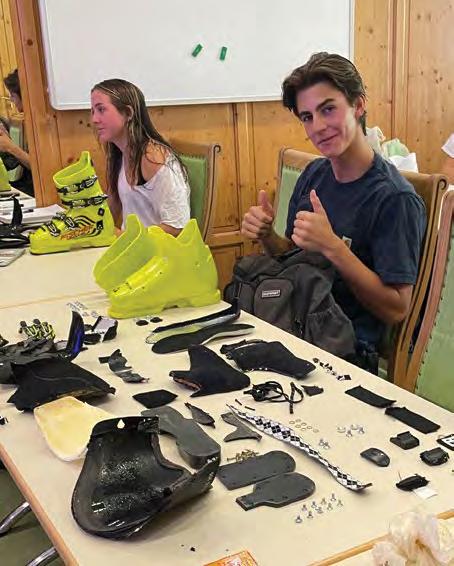
This year’s subject matter featured selections from Roald Dahl’s autobiography of his early years, Boy, a vivid and compelling testament to the depravity of British boarding schools of that time and an experience very unlike that of life at BMA.
Freed from rigid expectations about what is “right” or “permissible,” this bunch wrote entertaining stories of their own; many of them wrote about their shenanigans with one another, providing entertaining insights into their personal histories and long-lasting friendships.
Abi Ploof (BMA ’27) shared a piece called The Lost Turtle, which is reprinted on the next page.

This past October, history teacher David Chamberlain realized a long-held dream to teach a course on modern European history while traveling in Europe with students from Burke Mountain Academy. During a recent trip to Hintertux, Austria, Chamberlain led BMA seniors in a study of the rise of fascism in the 1920s and 1930s.
The course began with an overview of the three dominant political ideologies of the 20th century—liberalism, communism, and fascism.
Students explored how fascism arose primarily in response to the Russian Revolution. They worked through provocative readings that shed light on how the Nazis exploited lingering resentment over the Treaty of Versailles and anti-Semitic myths to justify their expansionist policies. Comparisons were also drawn between European fascism and its Japanese counterpart.
Students wrote papers responding to prompts about the origins of fascism for their culminating assessments. When the men’s team had to leave Hintertux early, the course transitioned to a hybrid model; FIS Men attended via Zoom, while FIS Women continued in person. The irony of analyzing fascist education policies while sitting in a kindergarten room was not lost on the students!
Despite the challenges of learning on the road, Chamberlain was proud of the students’ adaptability and engagement. Kate Levy (BMA ’24) came away “intrigued by the centrality of patriarchal thinking to Nazi ideology.” Helena Jankovic (BMA ’24) was struck by how “the Nazi desire for autarky was connected to their violent push for lebensraum.”
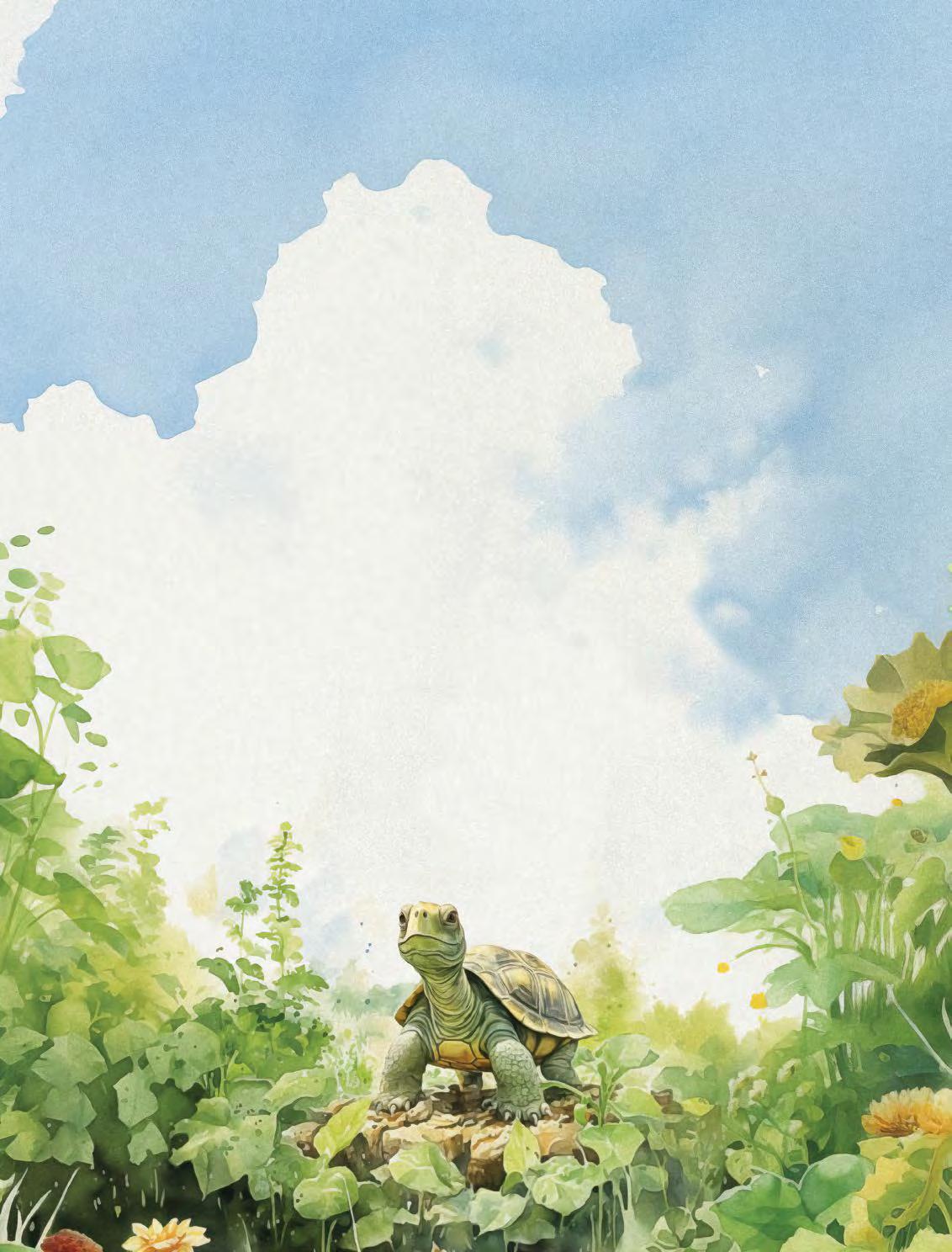
Abi produced The Lost Turtle as part of BMA’s Mini-Course on Personal Narratives. In this story, Abi recounts her experience caring for her classroom’s pet turtle. Along the way, she learns important lessons about listening and responsibility.
by ABI PLOOF’27There is not much I remember from my childhood not too long ago; however, there is one memory I remember vaguely. From the ages of 3 to 6, I attended a Montessori school in my home of Park City, UT. Montessori schools are known for having hands-on learning and letting the children choose their own education. For the school I attended, Little Miners Montessori, part of that learning was taking care of class pets. In my class, we had three pets: a lizard, a bunny, and a turtle. Sadly, the lizard’s name is lost in my memories; however, I believe the bunny’s name was Tom; Tom was a beige rabbit with black beady eyes who slept a lot. This story is not about Tom though. It is about the turtle, and this turtle went by Speedy.
Speedy was actually not a turtle at all, now that I think about it. Speedy was a tortoise because he had legs and not fins (if we want to get scientific). Anyways, Speedy looked like any pet tortoise or any tortoise you have seen in a store; he was about the size of a salad plate and was of brown coloring.
In the year 2014, I was 5 years old, and it was the start of April break. I was lucky enough to take Speedy home with me for the week. At the end of the school day, my teacher, Mrs. Karen, handed Speedy over to my mother and I along with his terrarium and food. One day, I decided to take Speedy outside with me to play in the sun, against my mother’s wishes. Everything was going well until I got up and went inside to grab something. When I went back outside, Speedy was gone.
I was full of fear. I could not tell my mother because I was not supposed to have Speedy outside.
I needed to find Speedy. Over the next hour, I looked everywhere: under the trampoline, in the garden, under the porch, and on any corner or rock. Speedy was nowhere to be found. Now I had to tell my mom.
As I predicted, my mom was livid when I told her I had lost the school turtle. I do not remember the talk she gave me, but I do know that she didn’t hold back. After she calmed down, and I pulled myself together, we went outside again and looked for Speedy until the sun had set and it was time for a very quiet dinner.
I was determined to find Speedy the next morning; my mother, on the other hand, suspected Speedy was long gone. Nevertheless, I went outside to look some more when my mom sat me down and told me that Speedy was not coming back and I needed to find a way to tell my teachers that I had lost the class pet.
Two days after Speedy’s disappearance, a miracle happened. My dog Cash, my dad, and I were outside in the garden when, all of a sudden, we spotted Speedy! Speedy was munching on our lettuce plant unharmed and without a care in the world. We could not believe it; my parents fully thought he was dead. However, Speedy was alive. We quickly brought him back inside to his enclosure. The rest of the week, Speedy never went outside again, and if I took him out of the enclosure, I needed an adult.
In the end, listen to your parents and keep a close eye on your turtle or tortoise.
An important ingredient in the BMA formula.
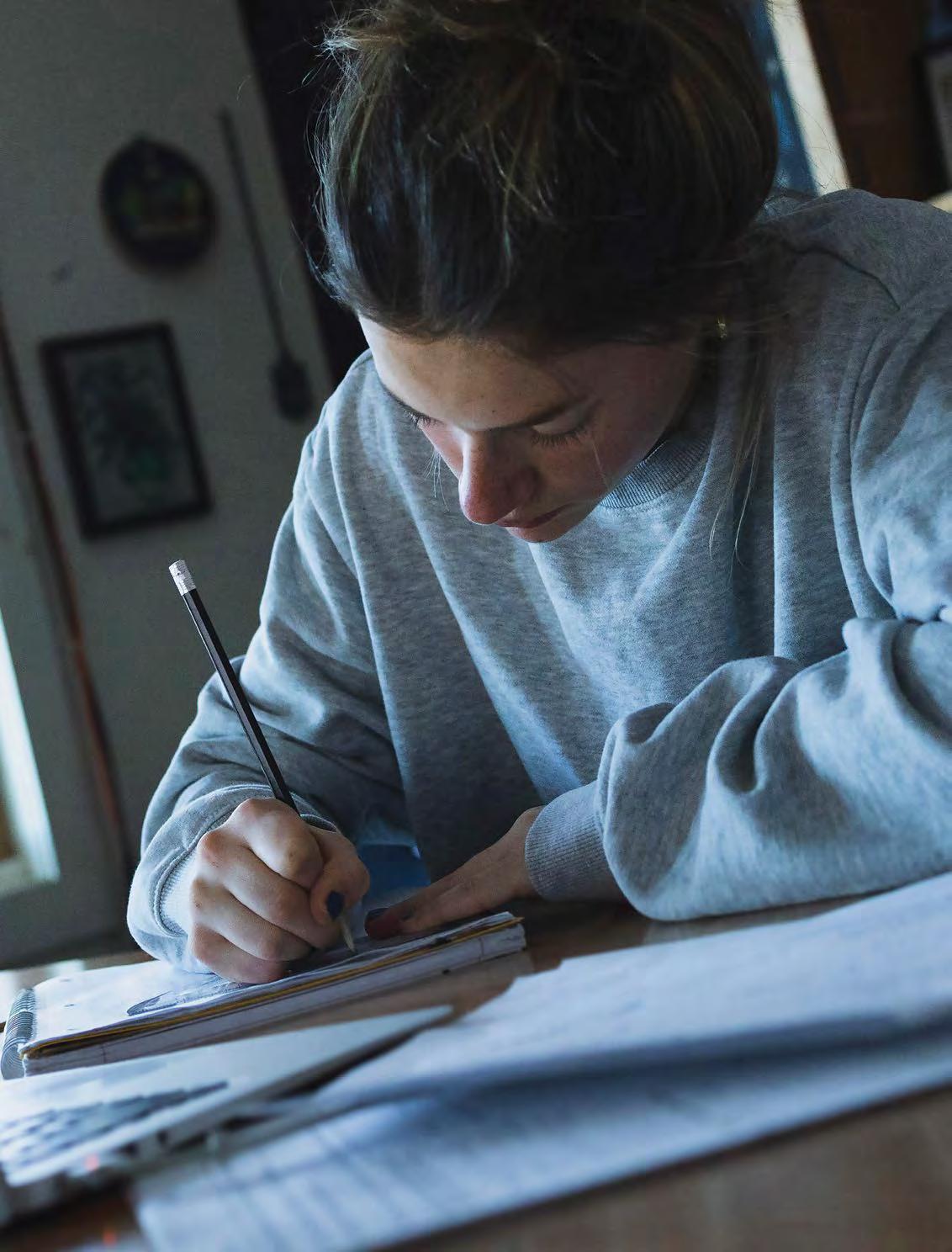
Alumni attending the 50-ish Celebration were also treated to a familiar tradition, Term Ends, courtesy of Tom DeCarlo, former BMA faculty member, who explained the essence of Term Ends in his essay titled, “What’s a Term End?”
by TOM DECARLOAs Tom writes, “They’re more than a trip down memory lane. Term Ends are a long-standing tradition that urges students to take a moment alone, put pen to paper, and reflect on their journey—past, present, and future. These reflections are a Burke tradition that predates the ’90s. The process offers valuable insights into personal growth, self-awareness, and the foundations of future success.
“If we don’t take stock of where we’ve been, how can we know where we are, or where we’re going?
All of us want to grow. We all want to become better students, athletes, members of the community. We all want to become better people. In this sense, Term Ends—the simple process of reflection through writing—provide all Burkies a tremendous opportunity.
“As students engage in their Term Ends, the expectation is not that they’ll have all the answers, but that they’ll start asking the right questions. The hope is that they’ll see some value in Socrates’ age-old maxim, ‘The unexamined life is not worth living.’”
The energy at BMA’s 50-ish Anniversary celebration is a testament to the resilience, growth, and amazing spirit of this incredible community we call Burke Mountain Academy. In toasting the past, present, and future, the 50-ish Celebration reminds us that the values we learned here continue to shape our lives even now. Term Ends are one small but vital aspect of how we learn those lessons. They’re one part of how and why BMA has built a legacy that stretches far beyond the school itself.
Here’s to 50-ish excellent years and the promise of countless more. Cheers, BMA!

“Doing one pull-up may seem small, but this accomplishment showed me what a huge difference my attitude can make in my productivity.”
by ESTELLE MARTIN’23
“Doing pull-up may seem showed what a attitude can make in my ESTELLE MARTIN’23
As a competitive athlete, I complete the SkillsQuest fitness assessment—more commonly known as physical testing—three times a year to gauge my overall strength and athletic ability. The test consists of running, long jumps, push-ups, box jumps, sprints, single-leg squats, and pull-ups. I can bench press or squat more than any girl at BMA, more than most ski racers in the country for that matter, but the pull-ups? I dread the pull-ups. For three years straight, when it came time for me to do my pull-ups, I would just dangle from the bar helplessly as I unsuccessfully tried to wiggle my way to one single pull-up. Alas.
After the last physical testing, and yet another failed pull-up attempt, I got down from the bar, looked at another big “ZERO” next to my name, and decided it was time to change.
I’m proud of my muscular legs, but unfortunately, they work against me when it comes to pullups—and that’s just one obstacle. The other one is that achieving a pull-up takes a long time. It’s a slow process because, to practice them fully, you actually have to be able to do one. As I mentioned, I cannot.
The spring after my final physical testing, I went to the Ronnie Berlack Center (RBC) almost every day and did pull-up-related exercises and bandsupported pull-ups. Two months later, nada. I still couldn’t do even one.
When summer rolled around, I lost my ability to work on pull-ups every day. I also stopped practicing pull-ups, so my lower body continued to get stronger, which meant I was only that much more unevenly distributed. I completed physical testing that next fall, and yet another
“ZERO” was logged next to my name for pull-ups. Over the next couple months, I stayed after workouts to work out even more. I went to the RBC after classes and on off-days during training. I even went after dinner to do band-supported pull-ups. Some days were tough, especially when I felt like I wasn’t making any progress. But I did them no matter what. No matter how tired I was. No matter how close or far to a pull-up I felt that day. I didn’t miss a day.
The next physical testing finally rolled around, and to everyone’s surprise—including my own—I finally did one pull-up. And to think, after just four short years!
Doing one pull-up may seem small, but this accomplishment showed me what a huge difference my attitude can make in my training and my overall productivity. It gave me confidence in my own abilities and even more confidence to push myself. I took my newfound “anything’s possible” mindset into the rest of my workouts and schoolwork that year. I pushed myself in the classroom, going well beyond the assigned classwork, and started approaching my studies with a greater focus on my own satisfaction. I wasn’t doing it simply to please my teachers. My work ethic and attitude shift also helped me with skiing and enabled me to improve my approach to training. I finished more runs and made every training day more productive.
Overall, reaching my goal of doing just one pull-up drastically changed all aspects of my life—from my athletics to my academics. A simple change in mentality showed me how a true “growth mindset” can change everything I do.
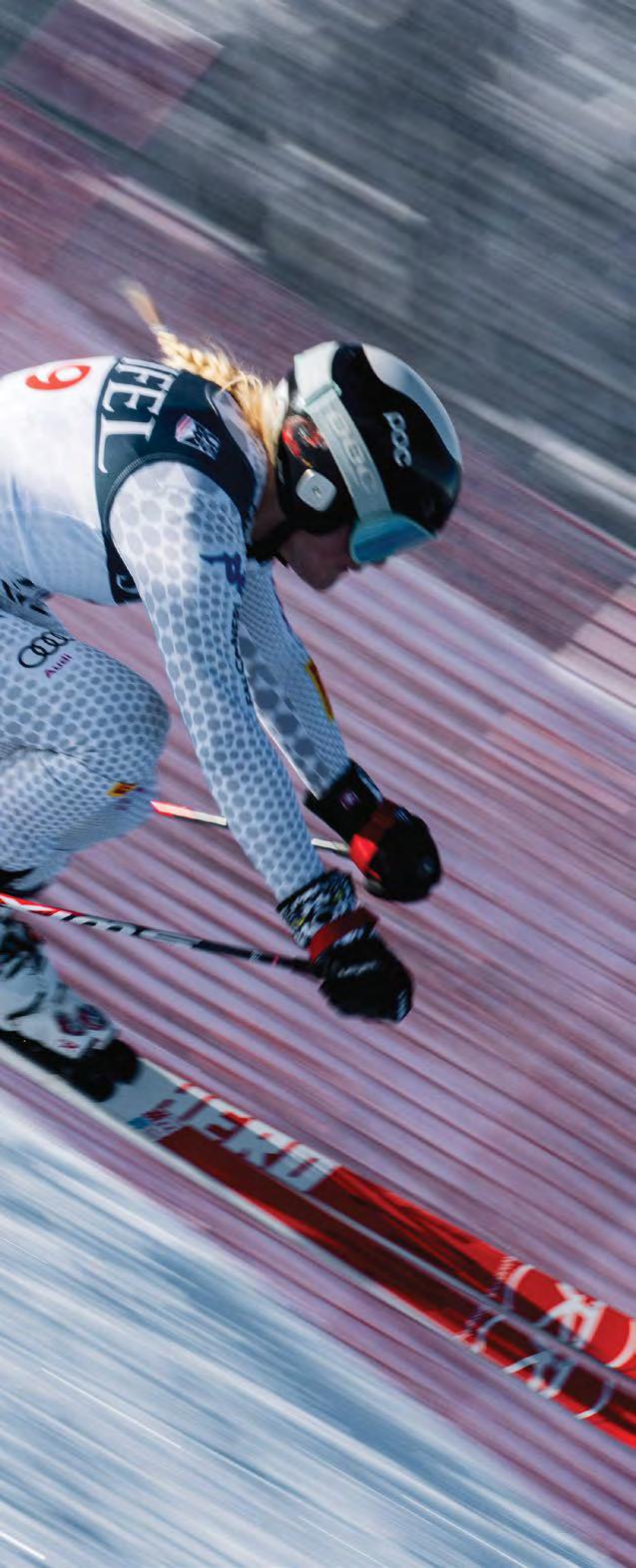
“…doing just one pull-up drastically changed all aspects of my life— from my athletics to my academics.”
ESTELLE MARTIN’23 Women’s NorAm at Burke Mountain.
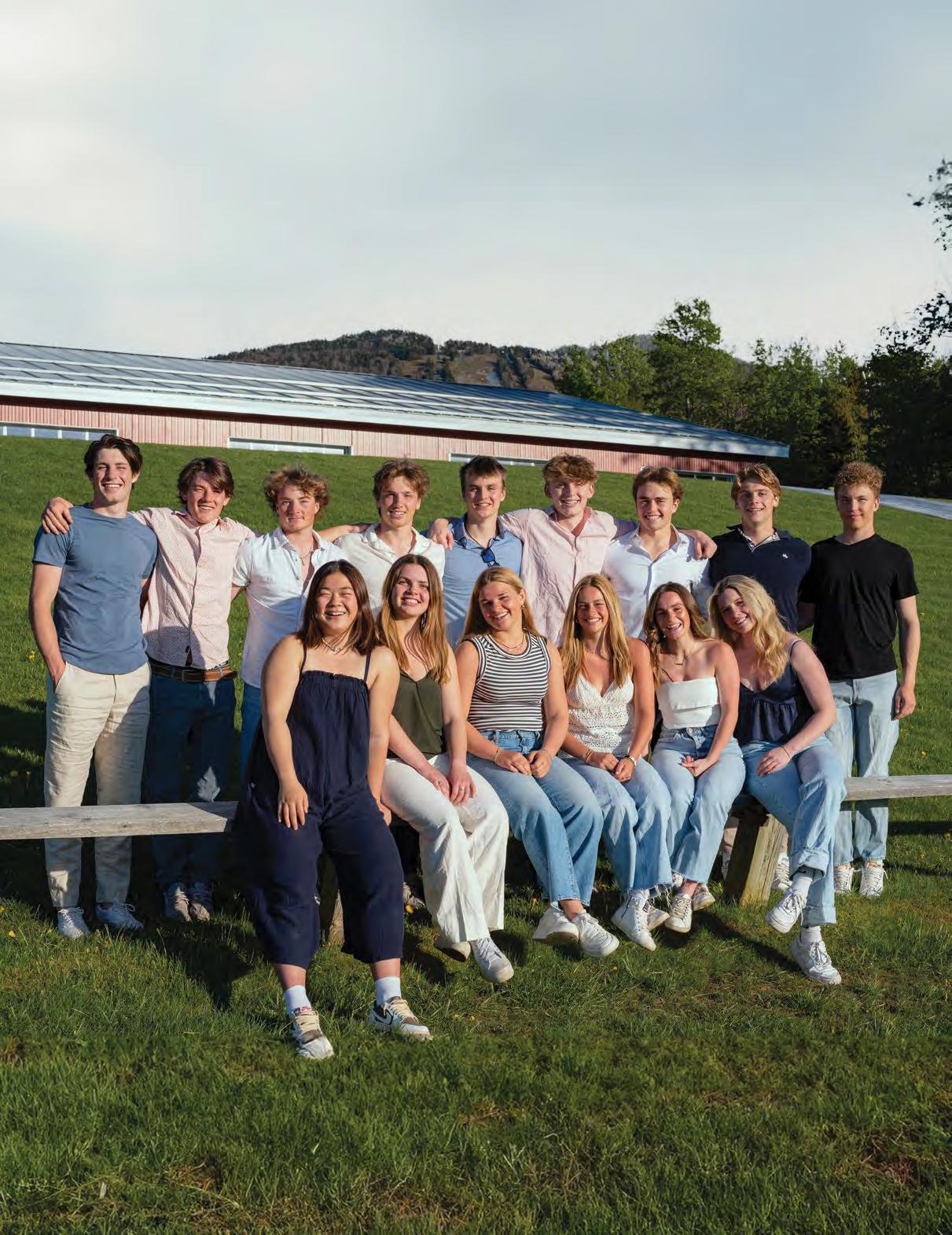
Burke Mountain Academy celebrates 52nd graduation ceremony.
by BURKE MOUNTAIN ACADEMY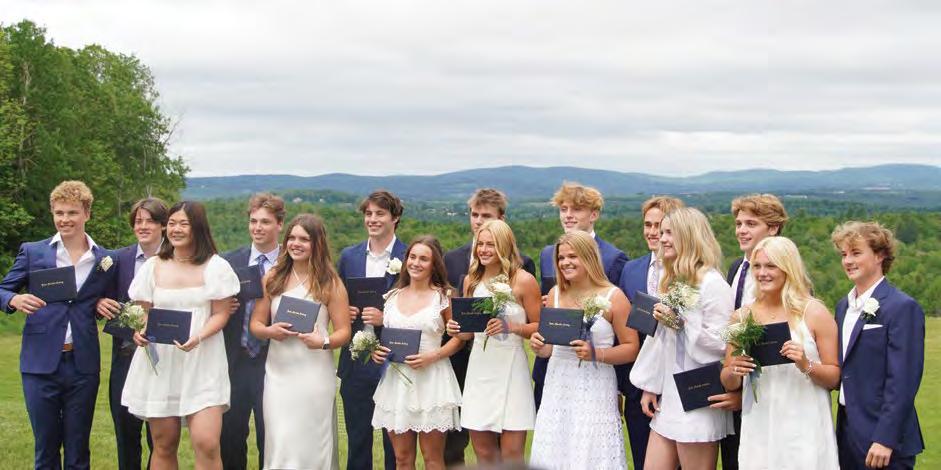
On Sunday, June 4, 2023, we proudly celebrated our 52nd Graduation Ceremony, marking a significant milestone in honoring the achievements of the Class of 2023.
Head of School Willy Booker ’96 extended a warm welcome to the students and guests, acknowledging the collective effort that contributed to the graduates’ success. Addressing the students, Booker welcomed them into the esteemed fraternity of BMA alumni and expressed gratitude to all who supported them on their transformative journey. He remarked, “They have uplifted and challenged you throughout the years, both in the classroom and on the hill. Together, you have shared moments of great success and forged lifelong friendships.”
The Graduation Address was delivered by Jonathan Gerkin, a dedicated educator and esteemed English and Literature teacher at Burke Mountain Academy. Reflecting on the senior class, Gerkin shared, “The curiosity and engagement of this class have struck me since our first day together.” He underscored the graduates’ unwavering determination and emphasized the value of hard work, stating,
“Nothing good comes without hard work and the willingness to push through the pain. We all know that the coward will die many deaths. None of the graduates that sit before you will face that fate. They have risked all to find out how far they can go in their sport day after day.”
Amid a brisk morning, the ceremony witnessed the awarding of 16 diplomas to the deserving graduates of Burke Mountain Academy.
In continuation of a cherished tradition at Burke Mountain Academy, a junior student took to the stage to deliver heartfelt speeches for each member of the graduating class. With shared memories and anecdotes, each senior stood to hear their classmates’ reflections and receive their well-earned diplomas.
The achievements of the Class of 2023 exemplify Burke Mountain Academy’s commitment to nurturing talent and fostering academic growth alongside athletic excellence. These exceptional individuals have excelled in their academic pursuits and demonstrated extraordinary skill, dedication, and resilience in ski racing.
“We all know the coward will die many deaths. None of the graduates that sit before you will face that fate.”
— JONATHAN GERKIN

Wenmiao Song, Beijing, China / Noémie Caroline
Wenmiao Song, Beijing, China
Laurie Longchamps, Montréal, Québec / Cate
Elizabeth Dance, Brisbane, Queensland, Australia
Emma Marie Powers, Thetford, Vermont / Lucy Noel Curtis, Hanover, New Hampshire / Keira Sophia Yardley, Stowe, Vermont / Estelle Martin, Montreal, Québec / William Steed, Edmonton, Alberta / Barrett
Christopher Hibshman, Burke, Vermont / William
Laurie Longchamps, Montréal, Elizabeth Dance, Brisbane, / Emma Marie Powers, Thetford, Noel Curtis, Hanover, New Yardley, Stowe, Vermont / Québec / William Steed, Edmonton, Christopher Hibshman, Burke, Levy Camp, Burlington, Hoffman, Sydney, Australia
Morrisville, Vermont / Benjamin Bethel, Maine / Colton Bartholomew Canada / Luke Hamel Dwyer,
Levy Camp, Burlington, Vermont / Harry David Hoffman, Sydney, Australia / Cailin Breck Apple, Morrisville, Vermont / Benjamin Warren Beckerman, Bethel, Maine / Colton Bartholomew Barrie, Ontario, Canada / Luke Hamel Dwyer, Lyme, New Hampshire
Spencer Richeda, Steamboat Springs, Colorado
/ Spencer Richeda, Steamboat
Willy Booker ’96
EDITOR
Meryl Willett, Marketing & Communications
DESIGNER
Grove Marketing
Burke Mountain Academy is a co-ed boarding school for elite ski racers in East Burke, Vermont. Since its founding, the school has produced more than 154 National Ski Team members and 37 Olympians and has earned a reputation as one of the top ski academies in the world. BMA provides passionate ski racers with the opportunity to pursue their limitless academic and athletic potential in a community based on trust.
www.burkemtnacademy.org
facebook.com/burkemountainacademy
@burkemtnacademy
Burke Mountain Academy